Stan C. Smith's Blog, page 30
March 20, 2019
Awesome Animal - Naked Mole Rat
Okay, I've been waiting to feature this animal for a long time. The naked mole rat does not make an appearance in any of my novels (at least not yet), but I am simply fascinated by this creature.
What is your concept of beauty? I don't mean physical beauty of people, which is greatly over-emphasized in pop culture. I'm talking about beauty in nature. Some people might think beauty is tall, snow-covered mountains. Others might think it's a wide open, undisturbed grassland, or an ancient forest. Or perhaps an animal, like a zebra or a bird of paradise. Well, beauty doesn't have to be physical (I'm not sure anyone would say these creatures are physically beautiful). But beauty can also be in the astounding adaptations of an animal or plant. Or in a bacterium, protozoan, or fungus, for that matter. It's the amazing adaptations and behaviors that make the naked mole rat a creature of beauty.
What the heck is a Naked Mole Rat?
One could argue that naked mole rats are the strangest mammals on Earth. But that's a matter of opinion, right? Let's look at them more closely so you can decide for yourself. Naked mole rats are not moles, nor are they rats. They are burrowing rodents that live in East Africa. This in itself is not unusual. After all, there are plenty of burrowing rodents, such as gophers, kangaroo rats, prairie dogs, and woodchucks.
But... naked mole rats are unique in a number of ways. The most striking is their social structure. Naked mole rats (and one other species of mole rat) are the ONLY mammal species that are eusocial. This is a type of social structure in which the adults live in groups and work together to care for the young, and only certain females (queens) are allowed to give birth. If you're thinking that's the way some ants, termites, bees, and wasps live, you're right. Those insects are eusocial. But there are no other mammals that are eusocial.
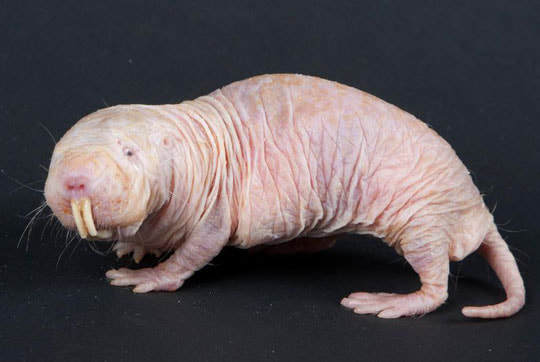
Amazing facts about Naked Mole Rats
Let's talk more about this eusocial thing. Hold on to your socks, because these amazing facts will just about knock them off! These creatures live in underground colonies, and when the queen dies, the dominant females basically start a war in order to choose which one will have the honor of being the new queen. As an example of how brutal this is, a captive colony of naked mole rats at the Smithsonian National Zoo needed a new queen, and during the selection process the number of adults was reduced from 17 to 13. The winning female in this case weighed 81 grams, while the closest competitor weighed only 55 grams. I guess size does matter.
Once a female becomes a queen, she starts having litters right away. Her first litter may have as few as two or three pups (each weighing less than a penny). But she'll get pregnant over and over, and each pregnancy will stretch her spine out a little more (seriously) until she can have room inside for up to 28 pups!
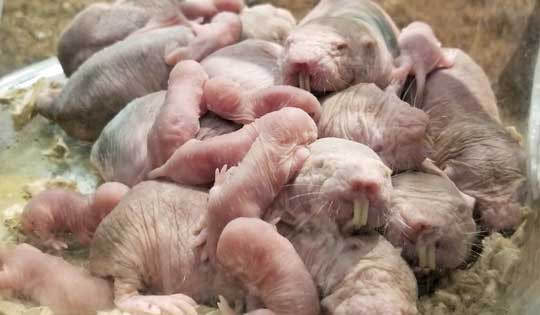
By the way, naked mole rats sleep in big, writhing piles (to help keep warm). That's why the pups in the photo above are piled with adults. One of those adults is the queen, the only one that will suckle the pups.
So, the queen nurses the pups until they are ready for solid food. At that point, the other adults in the colony take over care of the pups. They do this by feeding their poop to the pups! Yep, that's right. The adults produce a special kind of poop called cecotrope. This stuff is in the form of solid, yummy pellets that are full of good nutrients, as well as bacteria that the pups need in their guts to help them digest food as they grow older.
Check out this video on Naked Mole Rats
Let's take a look at the different roles in a naked mole rat colony. As stated above, there is one queen. And only one to three males reproduce with the queen. The other adults are called workers, and they are all sterile. The smaller workers typically gather food and take care of the nest. The larger workers are kind of like soldiers... if the burrow is attacked (by a snake looking for a snack, for example), these larger workers will defend the nest. In fact, they have been seen piling up at the entrance to block a snake from getting to the queen. This means that some of these soldiers might get eaten, thus sacrificing themselves for the queen. Wow.
All the workers, no matter their size, work together to take care of the pups.
As mentioned, other non-queen females in the colony are sterile. Amazingly, if the queen dies or is removed, some of the other females start producing certain hormones that make them fertile. And then they fight each other to become the queen. It is thought that the queen somehow suppresses fertility in all the other females in the colony. Again, wow!
Below is a pregnant queen:
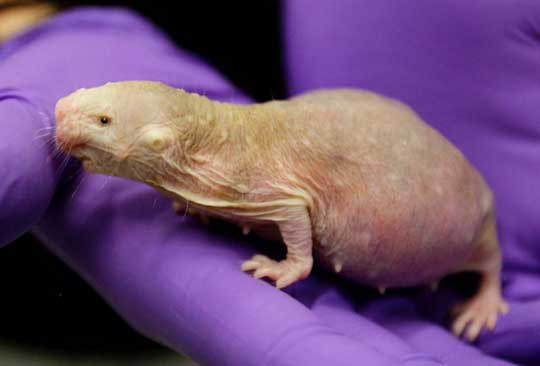
Here's another way mole rats are different from ALL other mammals: They are ectothermic. That means they are essentially cold-blooded. They do not produce heat internally, like other mammals do. Instead of regulating their temperature internally, they regulate it by changing their behavior. To stay warm, they sleep in restless, always-moving piles of mole rats. When they're hot, they move down to the deeper levels of the burrow, and when they're cold, they move up closer to the surface, which is warmed by the sun.
Naked mole rats are extremely well adapted to the low-oxygen environment of their burrows. They can go without any oxygen at all for 18 minutes with no negative effects! And they can carry on with their normal activities for five hours breathing air that has only 5% oxygen (the normal oxygen level of the atmosphere of Earth is just under 21%).
Naked mole rats, quite literally, feel no pain in their skin. This is because their skin lacks neurotransmitters. This is thought to be an adaptation to living in conditions with extremely high levels of carbon dioxide (they use up the oxygen in their burrows and end up breathing lots of CO2). When breathing high CO2 levels, acid builds up in the tissues, which normally would cause pain.
Naked mole rats don't drink water. They get all the moisture they need from the food they eat (the underground parts of plants, like roots and tubers).
A colony may include 75 to 80 individuals, and one colony's burrow system can include two to three miles (3-5 km) of tunnels. They dig these tunnels entirely with their teeth! Impressive, considering they don't even have dental insurance. Their lips seal closed behind their teeth, to keep the dirt out of their mouths. A whopping 25% of their muscle weight is the muscles involved with closing their mouths as they dig. If that were true for a human, our jaw muscles would be the size of all the muscles in one of our legs.
Below is a photo of naked mole rats digging cooperatively. This is called a digging chain.
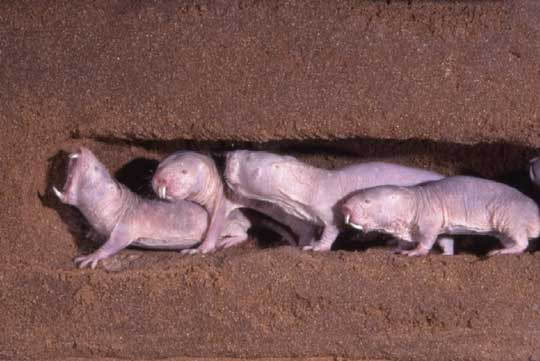
Naked mole rats live longer than any other rodents, up to 32 years! Most rodents this small (3 to 4 inches long, or 8 to 10 cm) live only a few years. Here's the weird thing about this: studies show that the mortality rate of these animals does NOT increase as they age. You may want to read that sentence again. They do NOT have more of a tendency to die as they grow older. In other words, they do not really age the way people do. They maintain a healthy heart and vascular system throughout their lives. And they are highly resistant to cancer. Pretty impressive, huh?
I'll finish with a cartoon from Lindsey Leigh that kind of summarizes (in a humorous way) the life of a mole rat colony.
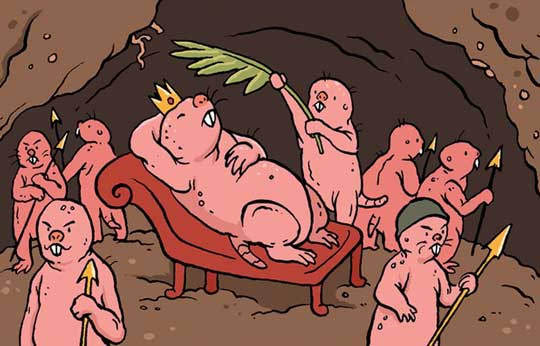
So, the Naked Mole Rat deserves a place in the C.A.H.O.F.
(Copacetic Animal Hall of Fame).
FUN FACT: The word copacetic is one of those rare words for which the origin is simply unknown. It is used almost exclusively in North America, and sources sometimes attribute it to Louisiana French, or to Italian, or even to Hebrew, among other possible origins. But the truth is, no one knows for sure. It's also unusual because it is not considered slang in its modern usage. The word means completely satisfactory, just fine, or excellent. So, copacetic is, more or less, another way to say awesome!
Photo Credits:
Naked Mole Rat #1 - Meghan Murphy, Smithsonian’s National Zoo
Naked Mole Rats with Pups - Liberty Science Center
Pregnant Naked Mole Rat - The Japan Times
Naked Mole Rat Digging Chain - Justin O’Riain via ResearchGate
Naked Mole Rat Cartoon - Lindsey Leigh via ScienceFocus
What is your concept of beauty? I don't mean physical beauty of people, which is greatly over-emphasized in pop culture. I'm talking about beauty in nature. Some people might think beauty is tall, snow-covered mountains. Others might think it's a wide open, undisturbed grassland, or an ancient forest. Or perhaps an animal, like a zebra or a bird of paradise. Well, beauty doesn't have to be physical (I'm not sure anyone would say these creatures are physically beautiful). But beauty can also be in the astounding adaptations of an animal or plant. Or in a bacterium, protozoan, or fungus, for that matter. It's the amazing adaptations and behaviors that make the naked mole rat a creature of beauty.
What the heck is a Naked Mole Rat?
One could argue that naked mole rats are the strangest mammals on Earth. But that's a matter of opinion, right? Let's look at them more closely so you can decide for yourself. Naked mole rats are not moles, nor are they rats. They are burrowing rodents that live in East Africa. This in itself is not unusual. After all, there are plenty of burrowing rodents, such as gophers, kangaroo rats, prairie dogs, and woodchucks.
But... naked mole rats are unique in a number of ways. The most striking is their social structure. Naked mole rats (and one other species of mole rat) are the ONLY mammal species that are eusocial. This is a type of social structure in which the adults live in groups and work together to care for the young, and only certain females (queens) are allowed to give birth. If you're thinking that's the way some ants, termites, bees, and wasps live, you're right. Those insects are eusocial. But there are no other mammals that are eusocial.

Amazing facts about Naked Mole Rats
Let's talk more about this eusocial thing. Hold on to your socks, because these amazing facts will just about knock them off! These creatures live in underground colonies, and when the queen dies, the dominant females basically start a war in order to choose which one will have the honor of being the new queen. As an example of how brutal this is, a captive colony of naked mole rats at the Smithsonian National Zoo needed a new queen, and during the selection process the number of adults was reduced from 17 to 13. The winning female in this case weighed 81 grams, while the closest competitor weighed only 55 grams. I guess size does matter.
Once a female becomes a queen, she starts having litters right away. Her first litter may have as few as two or three pups (each weighing less than a penny). But she'll get pregnant over and over, and each pregnancy will stretch her spine out a little more (seriously) until she can have room inside for up to 28 pups!

By the way, naked mole rats sleep in big, writhing piles (to help keep warm). That's why the pups in the photo above are piled with adults. One of those adults is the queen, the only one that will suckle the pups.
So, the queen nurses the pups until they are ready for solid food. At that point, the other adults in the colony take over care of the pups. They do this by feeding their poop to the pups! Yep, that's right. The adults produce a special kind of poop called cecotrope. This stuff is in the form of solid, yummy pellets that are full of good nutrients, as well as bacteria that the pups need in their guts to help them digest food as they grow older.
Check out this video on Naked Mole Rats
Let's take a look at the different roles in a naked mole rat colony. As stated above, there is one queen. And only one to three males reproduce with the queen. The other adults are called workers, and they are all sterile. The smaller workers typically gather food and take care of the nest. The larger workers are kind of like soldiers... if the burrow is attacked (by a snake looking for a snack, for example), these larger workers will defend the nest. In fact, they have been seen piling up at the entrance to block a snake from getting to the queen. This means that some of these soldiers might get eaten, thus sacrificing themselves for the queen. Wow.
All the workers, no matter their size, work together to take care of the pups.
As mentioned, other non-queen females in the colony are sterile. Amazingly, if the queen dies or is removed, some of the other females start producing certain hormones that make them fertile. And then they fight each other to become the queen. It is thought that the queen somehow suppresses fertility in all the other females in the colony. Again, wow!
Below is a pregnant queen:

Here's another way mole rats are different from ALL other mammals: They are ectothermic. That means they are essentially cold-blooded. They do not produce heat internally, like other mammals do. Instead of regulating their temperature internally, they regulate it by changing their behavior. To stay warm, they sleep in restless, always-moving piles of mole rats. When they're hot, they move down to the deeper levels of the burrow, and when they're cold, they move up closer to the surface, which is warmed by the sun.
Naked mole rats are extremely well adapted to the low-oxygen environment of their burrows. They can go without any oxygen at all for 18 minutes with no negative effects! And they can carry on with their normal activities for five hours breathing air that has only 5% oxygen (the normal oxygen level of the atmosphere of Earth is just under 21%).
Naked mole rats, quite literally, feel no pain in their skin. This is because their skin lacks neurotransmitters. This is thought to be an adaptation to living in conditions with extremely high levels of carbon dioxide (they use up the oxygen in their burrows and end up breathing lots of CO2). When breathing high CO2 levels, acid builds up in the tissues, which normally would cause pain.
Naked mole rats don't drink water. They get all the moisture they need from the food they eat (the underground parts of plants, like roots and tubers).
A colony may include 75 to 80 individuals, and one colony's burrow system can include two to three miles (3-5 km) of tunnels. They dig these tunnels entirely with their teeth! Impressive, considering they don't even have dental insurance. Their lips seal closed behind their teeth, to keep the dirt out of their mouths. A whopping 25% of their muscle weight is the muscles involved with closing their mouths as they dig. If that were true for a human, our jaw muscles would be the size of all the muscles in one of our legs.
Below is a photo of naked mole rats digging cooperatively. This is called a digging chain.

Naked mole rats live longer than any other rodents, up to 32 years! Most rodents this small (3 to 4 inches long, or 8 to 10 cm) live only a few years. Here's the weird thing about this: studies show that the mortality rate of these animals does NOT increase as they age. You may want to read that sentence again. They do NOT have more of a tendency to die as they grow older. In other words, they do not really age the way people do. They maintain a healthy heart and vascular system throughout their lives. And they are highly resistant to cancer. Pretty impressive, huh?
I'll finish with a cartoon from Lindsey Leigh that kind of summarizes (in a humorous way) the life of a mole rat colony.

So, the Naked Mole Rat deserves a place in the C.A.H.O.F.
(Copacetic Animal Hall of Fame).
FUN FACT: The word copacetic is one of those rare words for which the origin is simply unknown. It is used almost exclusively in North America, and sources sometimes attribute it to Louisiana French, or to Italian, or even to Hebrew, among other possible origins. But the truth is, no one knows for sure. It's also unusual because it is not considered slang in its modern usage. The word means completely satisfactory, just fine, or excellent. So, copacetic is, more or less, another way to say awesome!
Photo Credits:
Naked Mole Rat #1 - Meghan Murphy, Smithsonian’s National Zoo
Naked Mole Rats with Pups - Liberty Science Center
Pregnant Naked Mole Rat - The Japan Times
Naked Mole Rat Digging Chain - Justin O’Riain via ResearchGate
Naked Mole Rat Cartoon - Lindsey Leigh via ScienceFocus
Published on March 20, 2019 19:00
March 5, 2019
Awesome Animal - Coyote
Typically, my novels include encounters with strange creatures. In my recently-released novel,
INFINITY
, the characters encounter coyotes. Now, if you live in the United States, you may think coyotes are not all that strange. However, the coyotes in
INFINITY
are unlike any coyotes you've ever seen (I won't give away any more detail than that). But you don't have to bridge to an alternate version of Earth to find amazing animals, because the coyotes we have right here on this world are pretty impressive. Let's find out more.
What the heck is a Coyote?
Coyotes are members of the canine family (Canidae). Which means they are related to dogs, wolves, foxes, dingoes, jackals, and others. Coyotes live in North America, and they are widespread in Canada, the U.S., Mexico, and even into Central America.
Coyotes are medium-sized canines, smaller than wolves, larger than foxes. Typically, adults weigh between 15 and 44 pounds (7 to 20 kg). When you see one up close, you might assume it is heavier than that because of the bushy fur on its body and tail. The largest specimen ever recorded was a huge male killed in Wyoming in 1937, which weighed 75 pounds (34 kg).

Amazing facts about Coyotes
All coyotes belong to the same species, but there are a whopping 19 subspecies, each of them unique in its own way. Among these subspecies are the northern coyote, plains coyote, mountain coyote, Mexican coyote, Belize coyote, and many more. A very diverse species!
Coyotes are predators but will eat just about anything: rodents, rabbits, fish, frogs, snakes, insects, birds, and even grass and fruits. Studies show that mammals make up 90% of their diet. In fact, they are pretty impressive as predators when they hunt cooperatively to kill deer.
Yep, coyotes are capable of killing adult deer, even though coyotes are MUCH smaller. The average size for a white-tailed deer buck is 150 to 300 pounds (68 to 136 kg). To accomplish this, coyotes hunt large prey in pairs or in small groups. Bringing down an adult deer, especially a buck, is dangerous, though, and usually younger, less experienced coyotes do not participate in this.
Another dangerous prey animal is the porcupine, a large rodent with numerous sharp quills on its back. Many adult coyotes have learned to work in pairs to flip these rodents over and then attack the soft belly. This takes skill, and when younger coyotes try it, they often get a face full of needle-sharp quills.
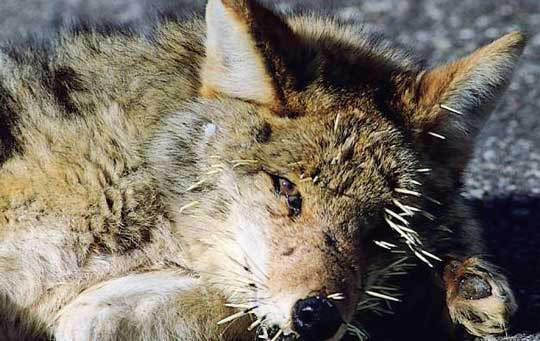
But I think my favorite coyote hunting skill is their ability to pounce. They like to stand still and watch for rodents in the snow or grass. When they see one, they leap high into the air and come down on it from above. This technique tends to be highly effective, and therefore mice, rats, and voles make up a large part of a coyote's diet.
Humans have a love/hate relationship with coyotes, and the hate side often outweighs the love side. There are many reasons for this. Farmers and ranchers, for example, hate coyotes because these canines sometimes kill calves and other young livestock. Hunters hate them because coyotes kill deer, turkeys, geese, pheasants, and other game. Pet owners hate them because coyotes sometimes attack domestic dogs.
These bad feelings toward coyotes have long been a part of North American attitudes, and coyotes are often portrayed in stories and cartoons as sneaky and devious. An example is Wile E. Coyote, the cartoon character who never gives up trying to catch the roadrunner, but always seems to fail in the most spectacular of ways.
Check out this Wile E. Coyote video
Coyotes are prolific. Females give birth to as many as 12 pups, and both the parents care for the pups, which results in a high survival rate of the entire litter. Research has shown that human attempts to curtail a coyote population often don't work because even if up to 75% of a coyote population is killed, these amazing creatures bounce right back to their previous level the next year. Since coyotes have few natural predators (besides humans), their populations are usually self-regulated by disease, or by the carrying capacity of their environment (the amount of food and space the environment offers).
Coyotes are highly adaptable, and their range has expanded dramatically because of human activities. Before the 1800s, coyotes were mostly restricted to the southwest United States and in low numbers in the midwest. This was mainly because wolves prevented them from spreading. But humans have wiped out most of the wolves in North America, which opened up new territory for coyotes. By the 1970s, coyotes had spread across the continent, even far up into Canada. In fact, they even spread to the Canadian island of Newfoundland, presumably by swimming (coyotes are very good swimmers). Remarkably, some of the coyotes of Newfoundland are white! They're called snow coyotes:

There's an interesting story behind the snow coyote. A group of scientists recently studied some of these creatures by sequencing their genes. They found that each white coyote carries two copies of a specific gene related to hair color. The normal coyotes on Newfoundland have only one copy of this gene (which means the gene is recessive).
Now here's where it gets interesting. Scientists have found this particular gene before—in golden retrievers. It's what makes the dogs have light-colored hairs. Here's my favorite part of the story: In Newfoundland in 2002, during the coyote breeding season, a male golden retriever ran off with a local coyote and never returned home.
Did you know that coyotes often interbreed with wolves and domestic dogs? It's true. Hmm... so it's very possible that this golden retriever bred with the coyote, and they had puppies bearing the gene described above. Since the puppies only had one copy of the gene, they would have been normal in color. But after a few generations, some of these one-copy offspring probably interbred and produced two-copy offspring... and in this case the genes created nearly-white fur instead of the blonde fur seen in golden retrievers.
I just love that kind of story!
Okay, one more tidbit about coyotes. As stated above, coyotes are adaptable. In fact, they have learned to thrive in human-influenced environments. Coyotes are now becoming common in city suburbs and even in the centers of large cities. For example, only five miles from Chicago O'Hare International Airport, scientists have discovered the smallest known coyote territory ever observed. For at least six years, a coyote community has lived within about a third of a square mile. That must mean that the creatures are finding it very easy to locate plenty of food and water right there in that tiny urban area.
Again, people have mixed feelings about urban and suburban coyotes. What do you think? Should we try to wipe out these new city dwellers, or should we just accept them as another part of the urban landscape, like the pigeons and feral cats?

So, the Coyote deserves a place in the T.A.H.O.F.
(Tubular Animal Hall of Fame).
FUN FACT: Dude, you know where tubular comes from, right? Well, let's start at the beginning. The word actually originated in the late 1600s, and it meant "having the form or shape of a tube." But in the late 1970s, surfers started using the word to describe when waves break like a barrel. With the help of the Frank Zappa song "Valley Girl," written and sung by his daughter Moon Unit, the word began to be used widely to mean something "cool" or "excellent." Now the word is pretty much just used as a way of mocking the 1980s. Nevertheless, tubular is another way to say awesome!
Photo Credits:
Coyote in snow - Yathin S Krishnappa via constantinealexander.net
Coyote with porcupine quills - Nicerweb
Coyote pouncing on rodent - Justin Jensen via Flicker
Snow Coyote - Michael Blackwood via National Geographic
Urban coyote - Matt Knoth/Shutterstock via Mother Nature Network
What the heck is a Coyote?
Coyotes are members of the canine family (Canidae). Which means they are related to dogs, wolves, foxes, dingoes, jackals, and others. Coyotes live in North America, and they are widespread in Canada, the U.S., Mexico, and even into Central America.
Coyotes are medium-sized canines, smaller than wolves, larger than foxes. Typically, adults weigh between 15 and 44 pounds (7 to 20 kg). When you see one up close, you might assume it is heavier than that because of the bushy fur on its body and tail. The largest specimen ever recorded was a huge male killed in Wyoming in 1937, which weighed 75 pounds (34 kg).

Amazing facts about Coyotes
All coyotes belong to the same species, but there are a whopping 19 subspecies, each of them unique in its own way. Among these subspecies are the northern coyote, plains coyote, mountain coyote, Mexican coyote, Belize coyote, and many more. A very diverse species!
Coyotes are predators but will eat just about anything: rodents, rabbits, fish, frogs, snakes, insects, birds, and even grass and fruits. Studies show that mammals make up 90% of their diet. In fact, they are pretty impressive as predators when they hunt cooperatively to kill deer.
Yep, coyotes are capable of killing adult deer, even though coyotes are MUCH smaller. The average size for a white-tailed deer buck is 150 to 300 pounds (68 to 136 kg). To accomplish this, coyotes hunt large prey in pairs or in small groups. Bringing down an adult deer, especially a buck, is dangerous, though, and usually younger, less experienced coyotes do not participate in this.
Another dangerous prey animal is the porcupine, a large rodent with numerous sharp quills on its back. Many adult coyotes have learned to work in pairs to flip these rodents over and then attack the soft belly. This takes skill, and when younger coyotes try it, they often get a face full of needle-sharp quills.

But I think my favorite coyote hunting skill is their ability to pounce. They like to stand still and watch for rodents in the snow or grass. When they see one, they leap high into the air and come down on it from above. This technique tends to be highly effective, and therefore mice, rats, and voles make up a large part of a coyote's diet.

Humans have a love/hate relationship with coyotes, and the hate side often outweighs the love side. There are many reasons for this. Farmers and ranchers, for example, hate coyotes because these canines sometimes kill calves and other young livestock. Hunters hate them because coyotes kill deer, turkeys, geese, pheasants, and other game. Pet owners hate them because coyotes sometimes attack domestic dogs.
These bad feelings toward coyotes have long been a part of North American attitudes, and coyotes are often portrayed in stories and cartoons as sneaky and devious. An example is Wile E. Coyote, the cartoon character who never gives up trying to catch the roadrunner, but always seems to fail in the most spectacular of ways.
Check out this Wile E. Coyote video
Coyotes are prolific. Females give birth to as many as 12 pups, and both the parents care for the pups, which results in a high survival rate of the entire litter. Research has shown that human attempts to curtail a coyote population often don't work because even if up to 75% of a coyote population is killed, these amazing creatures bounce right back to their previous level the next year. Since coyotes have few natural predators (besides humans), their populations are usually self-regulated by disease, or by the carrying capacity of their environment (the amount of food and space the environment offers).
Coyotes are highly adaptable, and their range has expanded dramatically because of human activities. Before the 1800s, coyotes were mostly restricted to the southwest United States and in low numbers in the midwest. This was mainly because wolves prevented them from spreading. But humans have wiped out most of the wolves in North America, which opened up new territory for coyotes. By the 1970s, coyotes had spread across the continent, even far up into Canada. In fact, they even spread to the Canadian island of Newfoundland, presumably by swimming (coyotes are very good swimmers). Remarkably, some of the coyotes of Newfoundland are white! They're called snow coyotes:

There's an interesting story behind the snow coyote. A group of scientists recently studied some of these creatures by sequencing their genes. They found that each white coyote carries two copies of a specific gene related to hair color. The normal coyotes on Newfoundland have only one copy of this gene (which means the gene is recessive).
Now here's where it gets interesting. Scientists have found this particular gene before—in golden retrievers. It's what makes the dogs have light-colored hairs. Here's my favorite part of the story: In Newfoundland in 2002, during the coyote breeding season, a male golden retriever ran off with a local coyote and never returned home.
Did you know that coyotes often interbreed with wolves and domestic dogs? It's true. Hmm... so it's very possible that this golden retriever bred with the coyote, and they had puppies bearing the gene described above. Since the puppies only had one copy of the gene, they would have been normal in color. But after a few generations, some of these one-copy offspring probably interbred and produced two-copy offspring... and in this case the genes created nearly-white fur instead of the blonde fur seen in golden retrievers.
I just love that kind of story!
Okay, one more tidbit about coyotes. As stated above, coyotes are adaptable. In fact, they have learned to thrive in human-influenced environments. Coyotes are now becoming common in city suburbs and even in the centers of large cities. For example, only five miles from Chicago O'Hare International Airport, scientists have discovered the smallest known coyote territory ever observed. For at least six years, a coyote community has lived within about a third of a square mile. That must mean that the creatures are finding it very easy to locate plenty of food and water right there in that tiny urban area.
Again, people have mixed feelings about urban and suburban coyotes. What do you think? Should we try to wipe out these new city dwellers, or should we just accept them as another part of the urban landscape, like the pigeons and feral cats?

So, the Coyote deserves a place in the T.A.H.O.F.
(Tubular Animal Hall of Fame).
FUN FACT: Dude, you know where tubular comes from, right? Well, let's start at the beginning. The word actually originated in the late 1600s, and it meant "having the form or shape of a tube." But in the late 1970s, surfers started using the word to describe when waves break like a barrel. With the help of the Frank Zappa song "Valley Girl," written and sung by his daughter Moon Unit, the word began to be used widely to mean something "cool" or "excellent." Now the word is pretty much just used as a way of mocking the 1980s. Nevertheless, tubular is another way to say awesome!
Photo Credits:
Coyote in snow - Yathin S Krishnappa via constantinealexander.net
Coyote with porcupine quills - Nicerweb
Coyote pouncing on rodent - Justin Jensen via Flicker
Snow Coyote - Michael Blackwood via National Geographic
Urban coyote - Matt Knoth/Shutterstock via Mother Nature Network
Published on March 05, 2019 06:23
February 18, 2019
Awesome Animal - Giant River Otter
I don't like giving spoilers about my upcoming novel,
INFINITY
, but I simply cannot resist telling you this. Our bridger heroes and their clients encounter river otters. But these otters are not like the otters you've seen here in our own world. The otters in
INFINITY
are... well, there I go again, trying to tell you too much!
I'll just say that the otters in INFINITY are why I chose today's Awesome Animal, the giant river otter. River otters have a reputation for being cute and playful (although those in INFINITY certainly are not), but are they really? Let's find out more about these creatures.
So, what the heck is a Giant River Otter?
Otters are carnivorous mammals in the family, Mustelidae (this is the family that includes all those long, skinny critters like ferrets, weasels, mink, martens, wolverines, and more). There are 13 living species of otters throughout the world, including the river otter, which is fairly common here in Missouri. The giant river otter , on the other hand, lives in South America, particularly in the Amazon River Basin. This is the largest living otter species, and it grows to 5.6 feet (1.7 m) and weighs up to 71 pounds (32 kg). In comparison, the North American river otter that lives here in Missouri weighs only 10 to 30 pounds.

Amazing facts about Giant River Otters
The giant river otter is one of three otter species in South America. But strangely, it is not as closely related to the other South American species as it is to the smooth-coated otter that lives in Asia.
Giant otters are the longest of all the mammals in the mustelid family, although the sea otter might be a bit heavier. Above, I gave the maximum length of 5.6 feet. But it is likely that they grow longer than this, as early reports on sightings and the skins of giant otters indicated that there used to be huge males that were as long as 7.9 feet (2.4 m). Try to imagine swimming next to an 8-foot otter! Unfortunately, these large individuals are not seen today due to overhunting.
Giant otters are classified as endangered. Hunting them is now illegal, but their numbers are still being reduced by deforestation, water pollution due to runoff from farms and oil drilling sites, and poaching (it is hard to catch poachers in the area where giant otters live).
Giant otter babies (called cubs) are born completely covered in fur. In fact, they are one of the few species of carnivores with noses that are completely covered in fur. The cubs are usually born in underground dens near the banks of slow-moving rivers. They are helpless at birth, and they don't learn to swim until they are two months old.
Below is a giant otter pup born in a zoo in Singapore.

Giant river otters, like other otter species, live in family groups, and they are very social. In fact, their social behaviors include hunting, grooming, resting, and communicating. For communicating, they have nine different vocalizations. Most of these are probably for locating each other or for warning each other about predators.
Here's an explanation for why otters play together so often. First, it's important to understand that otter social behavior and cooperation are crucial to their survival (the obvious example is cooperative hunting). When otters play together, they are strengthening their social bonds, thus insuring effective cooperative behaviors.
Check out this video of a family of giant otters working together to kill a large caiman.
Although giant otters typically eat fish, they often kill and eat larger prey. And they are always hungry. They eat six to nine pounds of food per day! In addition to fish, they also eat crustaceans, snakes, and just about any other river creatures they can catch and kill.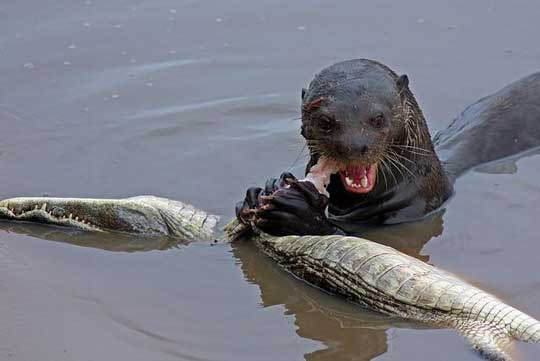
All otters are excellent swimmers, including the giant river otter. They propel themselves with their tail and with their large, webbed feet. They also flex their long bodies as they swim. Their thick, water-repellant fur keeps their skin dry and warm. And, as if that weren't enough, they can close their nostrils and ears to keep the water out. You've probably noticed that otters have very small ears. This helps their speed also.
Giant otter family groups usually have four to eight individuals, but families of up to twenty have been observed. A family group is usually the two parents (which are monogamous) and the last one or two litters of pups.
Each family group has a large home territory, averaging almost five square miles (12 square km). They patrol their territory regularly, marking the borders with their anal glands. If other otters trespass, they will defend their territory viciously.
Within a family group, the subadults have the task of caring for the newest pups. So they are kind of like sibling babysitters.
Giant otters are mostly dark brown, but each individual has a white marking from the chin to the chest. These markings are different on each otter, and they use these to identify each other. It's interesting that these markings are in this location (on the chin). Otters have cool habit of "snorkeling," which is when they thrust themselves upward out of the water with their heads high. This allows them to see farther. But it also exposes their distinct markings to the other otters they are facing.
Check out the markings on these two giant otters:
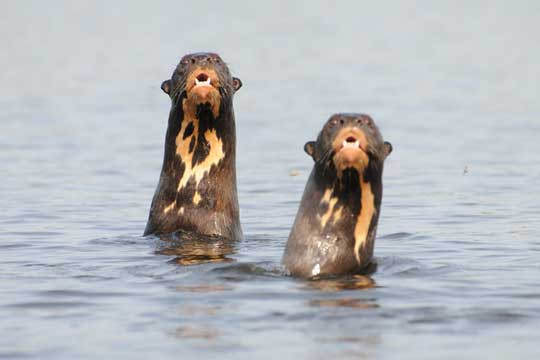
So, the Giant River Otter deserves a place in the S.G.A.H.O.F.
(Squad Goal Animal Hall of Fame).
FUN FACT: Okay, this one's really a stretch. I was reading an article about slang terms that millennials use. The phrase squad goal is used to describe the type of behavior that friend groups aspire to. Here's an example: When you see Harry Potter and his friends gear up to defeat the Dark Lord, you could say "Squad goal." This means you admire the way the group is working together, and you are suggesting that your own group (squad) should strive to work together in such a way. And since giant river otters are so good at cooperative efforts, I thought this phrase was perfect. So, squad goal is another way to say awesome! Photo Credits:
Giant Otter Underwater - Wildlife Reserves Singapore
Giant Otter Pup - Zooborns
Otter eating caiman - Reddit
Giant Otters Snorkeling - World Land Trust
I'll just say that the otters in INFINITY are why I chose today's Awesome Animal, the giant river otter. River otters have a reputation for being cute and playful (although those in INFINITY certainly are not), but are they really? Let's find out more about these creatures.
So, what the heck is a Giant River Otter?
Otters are carnivorous mammals in the family, Mustelidae (this is the family that includes all those long, skinny critters like ferrets, weasels, mink, martens, wolverines, and more). There are 13 living species of otters throughout the world, including the river otter, which is fairly common here in Missouri. The giant river otter , on the other hand, lives in South America, particularly in the Amazon River Basin. This is the largest living otter species, and it grows to 5.6 feet (1.7 m) and weighs up to 71 pounds (32 kg). In comparison, the North American river otter that lives here in Missouri weighs only 10 to 30 pounds.

Amazing facts about Giant River Otters
The giant river otter is one of three otter species in South America. But strangely, it is not as closely related to the other South American species as it is to the smooth-coated otter that lives in Asia.
Giant otters are the longest of all the mammals in the mustelid family, although the sea otter might be a bit heavier. Above, I gave the maximum length of 5.6 feet. But it is likely that they grow longer than this, as early reports on sightings and the skins of giant otters indicated that there used to be huge males that were as long as 7.9 feet (2.4 m). Try to imagine swimming next to an 8-foot otter! Unfortunately, these large individuals are not seen today due to overhunting.
Giant otters are classified as endangered. Hunting them is now illegal, but their numbers are still being reduced by deforestation, water pollution due to runoff from farms and oil drilling sites, and poaching (it is hard to catch poachers in the area where giant otters live).
Giant otter babies (called cubs) are born completely covered in fur. In fact, they are one of the few species of carnivores with noses that are completely covered in fur. The cubs are usually born in underground dens near the banks of slow-moving rivers. They are helpless at birth, and they don't learn to swim until they are two months old.
Below is a giant otter pup born in a zoo in Singapore.

Giant river otters, like other otter species, live in family groups, and they are very social. In fact, their social behaviors include hunting, grooming, resting, and communicating. For communicating, they have nine different vocalizations. Most of these are probably for locating each other or for warning each other about predators.
Here's an explanation for why otters play together so often. First, it's important to understand that otter social behavior and cooperation are crucial to their survival (the obvious example is cooperative hunting). When otters play together, they are strengthening their social bonds, thus insuring effective cooperative behaviors.
Check out this video of a family of giant otters working together to kill a large caiman.
Although giant otters typically eat fish, they often kill and eat larger prey. And they are always hungry. They eat six to nine pounds of food per day! In addition to fish, they also eat crustaceans, snakes, and just about any other river creatures they can catch and kill.

All otters are excellent swimmers, including the giant river otter. They propel themselves with their tail and with their large, webbed feet. They also flex their long bodies as they swim. Their thick, water-repellant fur keeps their skin dry and warm. And, as if that weren't enough, they can close their nostrils and ears to keep the water out. You've probably noticed that otters have very small ears. This helps their speed also.
Giant otter family groups usually have four to eight individuals, but families of up to twenty have been observed. A family group is usually the two parents (which are monogamous) and the last one or two litters of pups.
Each family group has a large home territory, averaging almost five square miles (12 square km). They patrol their territory regularly, marking the borders with their anal glands. If other otters trespass, they will defend their territory viciously.
Within a family group, the subadults have the task of caring for the newest pups. So they are kind of like sibling babysitters.
Giant otters are mostly dark brown, but each individual has a white marking from the chin to the chest. These markings are different on each otter, and they use these to identify each other. It's interesting that these markings are in this location (on the chin). Otters have cool habit of "snorkeling," which is when they thrust themselves upward out of the water with their heads high. This allows them to see farther. But it also exposes their distinct markings to the other otters they are facing.
Check out the markings on these two giant otters:

So, the Giant River Otter deserves a place in the S.G.A.H.O.F.
(Squad Goal Animal Hall of Fame).
FUN FACT: Okay, this one's really a stretch. I was reading an article about slang terms that millennials use. The phrase squad goal is used to describe the type of behavior that friend groups aspire to. Here's an example: When you see Harry Potter and his friends gear up to defeat the Dark Lord, you could say "Squad goal." This means you admire the way the group is working together, and you are suggesting that your own group (squad) should strive to work together in such a way. And since giant river otters are so good at cooperative efforts, I thought this phrase was perfect. So, squad goal is another way to say awesome! Photo Credits:
Giant Otter Underwater - Wildlife Reserves Singapore
Giant Otter Pup - Zooborns
Otter eating caiman - Reddit
Giant Otters Snorkeling - World Land Trust
Published on February 18, 2019 17:18
February 8, 2019
Awesome Animal - Komodo Dragon
I have a confession to make—I love creature movies (often called creature features). There, I said it. Any movie in which some rampaging creature causes terror and havoc. Of course, many of these movies are beyond silly, and they portray the creatures in a falsely-negative light (an extreme version of this was a 2006 movie about killer sheep, called
Black Sheep
).
But I don't care how silly these movies are. I still like them. One of my favorites is the 1999 film, Komodo , with its over-the-top punchline: Welcome to the bottom of the food chain.
 This movie, of course, is about Komodo dragons—really mean, hungry ones. But let's face it, Komodo dragons are just lizards. Sure, they are the largest and heaviest lizards alive today, and they have a venomous bite (kind of). But are they really that bad? Let's look at the truth about these creatures.
This movie, of course, is about Komodo dragons—really mean, hungry ones. But let's face it, Komodo dragons are just lizards. Sure, they are the largest and heaviest lizards alive today, and they have a venomous bite (kind of). But are they really that bad? Let's look at the truth about these creatures.
So, what the heck is a Komodo Dragon?
Komodo dragons are lizards in the monitor family (Varanidae). They are found on several Indonesian islands, including the island of Komodo. They are carnivores but don't hesitate to eat carrion. Growing up to ten feet (3.1m) long and weighing up to 366 pounds (166kg), they are by far the largest living lizards.

Amazing facts about Komodo dragons
The most obvious amazing characteristic is their size. There are two primary lines of thought regarding this. First, some scientists say this is an example of island gigantism. This is when animals isolated on islands tend to grow much larger than their relatives on the mainland. There are hundreds of examples of island gigantism, including giant shrews and rats, kiwis and other flightless birds, and various reptiles. Here's an explanation: small islands are usually devoid of large predatory mammals (often because small islands don't have enough food to support large warm-blooded predators that need more food than cold-blooded predators). In the absence of large predatory mammals, the smaller cold-blooded predators (such as lizards and snakes) can gradually become larger to fill that particular niche.
But... some scientists think that Komodo dragons are NOT examples of island gigantism. They point out that very large monitor lizards were already living on the mainland of Australia. In fact, some of the mainland lizards were much larger. One extinct species, the giant goanna, grew to 18 feet (5.5 m) and weighed 1,268 pounds (575 kg)!
So, these scientists suggest that Komodo dragons are large simply because they are descended from large ancestors.
Regardless of how they got that way, Komodo dragons are impressively large lizards.

Komodo dragons were not documented by scientists until 1910. A few collected skins of these lizards made their way to scientists, who were fascinated by the creatures' size. In 1926, W. Douglas Burden organized an expedition to Komodo island, mainly because of the reports of Komodo dragons. After the expedition returned with several preserved specimens and two live ones, the story of the expedition inspired the 1933 movie, King Kong (a movie I still love to watch!).
Are Komodo dragons really venomous? This is an interesting question, because there have been many misconceptions in the past. People used to believe that the saliva of these lizards was filled with nasty bacteria, and that once bitten, their prey would soon die and the lizards would then track them down by smell. Well, a recent study showed that Komodo dragon saliva is no different from the saliva of any other carnivore. They don't have rotting flesh stuck between their teeth, filled with dangerous bacteria. In fact, they meticulously clean their mouths for 15 minutes after eating a meal.
Okay, so the saliva myth has been largely disproven. What about actual venom? In 2009, scientists identified two glands in the lower jaw and extracted the fluid from these glands. They analyzed the fluid, finding that it contained two toxic proteins known to cause symptoms such as muscle paralysis and hypothermia, which could lead to loss of consciousness in their prey.
So... YES, they are venomous. BUT there's more to the story. Many scientists don't think these toxic substances have all that much to do with killing their prey. Why? Because Komodo dragons usually kill their prey very quickly. They've been observed killing wild pigs in only a few seconds. They do not bite and intentionally release their prey so that they can track them down later by smell. After all, if they already have the animal in their mouth, why let it go?
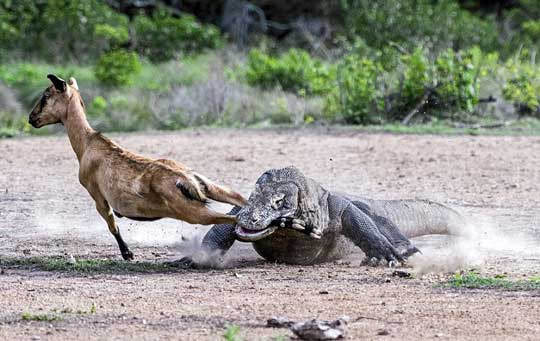
Komodo dragons are often scavengers, and they can smell a dead carcass as far away as 5.9 miles (9.5km). But they also hunt live prey, and they are fierce predators. Astoundingly, they can eat up to 80% of their own body weight in one meal! When they kill larger prey (too large to swallow whole), they tear off massive chunks. They will eat as much as 88% of a carcass: the bones, hooves, some of the skin, and the internal organs, including intestines.
Now here's the most amazing part. With prey up to the size of a goat, Komodo dragons can swallow the creature whole. Snakes are capable of such things, but remember, this is a lizard. To make room, they have flexible skulls and jaws. They also have an expandable stomach. Swallowing such large prey is not a quick job. It can take 20 minutes to swallow a goat, even though they have copious amounts of slick saliva to help the food go down.
Check out this video of a Komodo dragon swallowing a large monkey
(but only if you're not grossed out by such things)
Komodo dragons have been known to try to speed up this process by running at a tree and ramming into it to push the creature down their throat. In fact, they've even been seen knocking over trees while doing this.
Komodo dragons will eat just about anything they can catch, including invertebrates, snakes, other lizards, small mammals, goats, deer, horses, and water buffalo. They even eat each other.
Although they can be fierce, they only occasionally attack humans. I could only find a handful of documented cases of humans being attacked. One of them was a national park guide who went into his office to sit at his desk. Unfortunately, a Komodo dragon had wandered in the open door of his office and was hiding under his desk. The guide survived but was injured.
So, even though I like the 1999 movie, Komodo , the film does NOT accurately portray the true nature of these wonderful creatures.
And Komodo dragons aren't always giant, fierce-looking lizards. As babies, they're actually kind of cute.
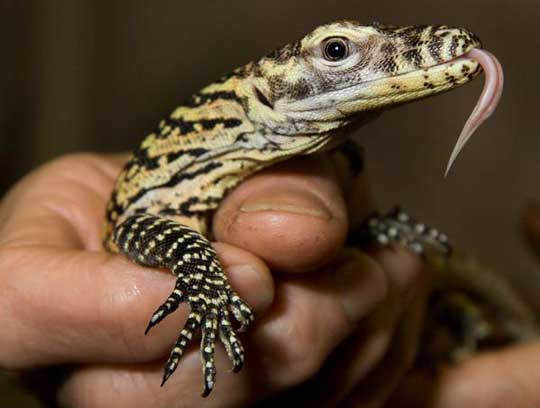
So, the Komodo dragon deserves a place in the K.A.H.O.F.
(Killer Animal Hall of Fame).
FUN FACT: The word killer was first used in about 1525. Its original meaning was, a person or thing that kills, as in "The detective finally captured the killer." At some point it took on the meaning, something severe, powerful, or difficult, as in "That was a killer snowstorm," or "That was a killer final exam." Finally, more recently, it has come to mean, highly effective or superior, as in "That is a killer fried chicken recipe." Considering the nature of the Komodo dragon, I think this word is perfect. So, killer is another way to say awesome!
Photo Credits:
Komodo Dragon #1 - Smithsonian's National Zoo
Man with Komodo Dragon - Jerry Fife via Reptile Magazine
Komodo Dragon attacking goat - Caters News Agency via UK Daily Mail
Baby Komodo dragon - The Denver Post
But I don't care how silly these movies are. I still like them. One of my favorites is the 1999 film, Komodo , with its over-the-top punchline: Welcome to the bottom of the food chain.
 This movie, of course, is about Komodo dragons—really mean, hungry ones. But let's face it, Komodo dragons are just lizards. Sure, they are the largest and heaviest lizards alive today, and they have a venomous bite (kind of). But are they really that bad? Let's look at the truth about these creatures.
This movie, of course, is about Komodo dragons—really mean, hungry ones. But let's face it, Komodo dragons are just lizards. Sure, they are the largest and heaviest lizards alive today, and they have a venomous bite (kind of). But are they really that bad? Let's look at the truth about these creatures.So, what the heck is a Komodo Dragon?
Komodo dragons are lizards in the monitor family (Varanidae). They are found on several Indonesian islands, including the island of Komodo. They are carnivores but don't hesitate to eat carrion. Growing up to ten feet (3.1m) long and weighing up to 366 pounds (166kg), they are by far the largest living lizards.

Amazing facts about Komodo dragons
The most obvious amazing characteristic is their size. There are two primary lines of thought regarding this. First, some scientists say this is an example of island gigantism. This is when animals isolated on islands tend to grow much larger than their relatives on the mainland. There are hundreds of examples of island gigantism, including giant shrews and rats, kiwis and other flightless birds, and various reptiles. Here's an explanation: small islands are usually devoid of large predatory mammals (often because small islands don't have enough food to support large warm-blooded predators that need more food than cold-blooded predators). In the absence of large predatory mammals, the smaller cold-blooded predators (such as lizards and snakes) can gradually become larger to fill that particular niche.
But... some scientists think that Komodo dragons are NOT examples of island gigantism. They point out that very large monitor lizards were already living on the mainland of Australia. In fact, some of the mainland lizards were much larger. One extinct species, the giant goanna, grew to 18 feet (5.5 m) and weighed 1,268 pounds (575 kg)!
So, these scientists suggest that Komodo dragons are large simply because they are descended from large ancestors.
Regardless of how they got that way, Komodo dragons are impressively large lizards.

Komodo dragons were not documented by scientists until 1910. A few collected skins of these lizards made their way to scientists, who were fascinated by the creatures' size. In 1926, W. Douglas Burden organized an expedition to Komodo island, mainly because of the reports of Komodo dragons. After the expedition returned with several preserved specimens and two live ones, the story of the expedition inspired the 1933 movie, King Kong (a movie I still love to watch!).
Are Komodo dragons really venomous? This is an interesting question, because there have been many misconceptions in the past. People used to believe that the saliva of these lizards was filled with nasty bacteria, and that once bitten, their prey would soon die and the lizards would then track them down by smell. Well, a recent study showed that Komodo dragon saliva is no different from the saliva of any other carnivore. They don't have rotting flesh stuck between their teeth, filled with dangerous bacteria. In fact, they meticulously clean their mouths for 15 minutes after eating a meal.
Okay, so the saliva myth has been largely disproven. What about actual venom? In 2009, scientists identified two glands in the lower jaw and extracted the fluid from these glands. They analyzed the fluid, finding that it contained two toxic proteins known to cause symptoms such as muscle paralysis and hypothermia, which could lead to loss of consciousness in their prey.
So... YES, they are venomous. BUT there's more to the story. Many scientists don't think these toxic substances have all that much to do with killing their prey. Why? Because Komodo dragons usually kill their prey very quickly. They've been observed killing wild pigs in only a few seconds. They do not bite and intentionally release their prey so that they can track them down later by smell. After all, if they already have the animal in their mouth, why let it go?

Komodo dragons are often scavengers, and they can smell a dead carcass as far away as 5.9 miles (9.5km). But they also hunt live prey, and they are fierce predators. Astoundingly, they can eat up to 80% of their own body weight in one meal! When they kill larger prey (too large to swallow whole), they tear off massive chunks. They will eat as much as 88% of a carcass: the bones, hooves, some of the skin, and the internal organs, including intestines.
Now here's the most amazing part. With prey up to the size of a goat, Komodo dragons can swallow the creature whole. Snakes are capable of such things, but remember, this is a lizard. To make room, they have flexible skulls and jaws. They also have an expandable stomach. Swallowing such large prey is not a quick job. It can take 20 minutes to swallow a goat, even though they have copious amounts of slick saliva to help the food go down.
Check out this video of a Komodo dragon swallowing a large monkey
(but only if you're not grossed out by such things)
Komodo dragons have been known to try to speed up this process by running at a tree and ramming into it to push the creature down their throat. In fact, they've even been seen knocking over trees while doing this.
Komodo dragons will eat just about anything they can catch, including invertebrates, snakes, other lizards, small mammals, goats, deer, horses, and water buffalo. They even eat each other.
Although they can be fierce, they only occasionally attack humans. I could only find a handful of documented cases of humans being attacked. One of them was a national park guide who went into his office to sit at his desk. Unfortunately, a Komodo dragon had wandered in the open door of his office and was hiding under his desk. The guide survived but was injured.
So, even though I like the 1999 movie, Komodo , the film does NOT accurately portray the true nature of these wonderful creatures.
And Komodo dragons aren't always giant, fierce-looking lizards. As babies, they're actually kind of cute.

So, the Komodo dragon deserves a place in the K.A.H.O.F.
(Killer Animal Hall of Fame).
FUN FACT: The word killer was first used in about 1525. Its original meaning was, a person or thing that kills, as in "The detective finally captured the killer." At some point it took on the meaning, something severe, powerful, or difficult, as in "That was a killer snowstorm," or "That was a killer final exam." Finally, more recently, it has come to mean, highly effective or superior, as in "That is a killer fried chicken recipe." Considering the nature of the Komodo dragon, I think this word is perfect. So, killer is another way to say awesome!
Photo Credits:
Komodo Dragon #1 - Smithsonian's National Zoo
Man with Komodo Dragon - Jerry Fife via Reptile Magazine
Komodo Dragon attacking goat - Caters News Agency via UK Daily Mail
Baby Komodo dragon - The Denver Post
Published on February 08, 2019 06:40
January 23, 2019
Awesome Animal - Seahorse
Yesterday I asked Trish what animal I should feature in my newsletter. She didn't hesitate. She reminded me of the time we took our kids out snorkeling in the wide, shallow bay at Cape San Blas, Florida. We rented a couple of canoes, paddled into the center of the bay, and spent the day splashing around and looking for interesting creatures. The next day, we told a commercial fishing guide about that, and he said, "I wouldn't get in that water. A guy caught an eight-foot bull shark there the other day." Hmm. That would have been good to know 24 hours earlier.
Anyway, while we were snorkeling, we found a seahorse. It was only about two inches long, but it was exciting because we had never seen one in the wild before. I can't find a photo of it because back then the only waterproof cameras we had were those plastic, disposable things that used film. Remember film?
So, what the heck is a seahorse?
Seahorses include about 40 species of fish in the genus Hippocampus. They live in shallow tropical and subtropical marine habitats, hiding in seagrasses, mangroves, coral reefs, and other sheltered areas. These fish are best known for their upright posture, prehensile tail, and the fact that their heads and necks vaguely resemble that of a horse. But few people have seen them in the wild because they don't move around much, and they blend in with their surroundings.
Amazing facts about seahorses
Seahorses are ridiculously bad swimmers. Top speed: 150 cm per hour. Their tail (called the caudal fin on other fish) are not for swimming, so they swim mostly using their small dorsal (back) fin. This fin flips back and forth furiously, but as Ze Frank says, “Imagine trying to propel yourself on a skateboard solely by waving a Denny’s menu back and forth really fast.”
(by the way, zefrank1 has a collection of funny nature videos on YouTube... but avoid them if you are offended by slightly-raunchy jokes)
In spite of their slow swimming speed, seahorses are predators, feeding on small crustaceans. Obviously, they don't chase down their food. Instead, they wait motionless until their prey swim by, then they suck in the prey through their tube-like mouths.

Seahorses don't have a stomach. Seriously. And no teeth. Their food passes through their digestive system so fast that they have to eat constantly. A young, growing seahorse will eat up to 3,000 brine shrimp every day! I like shrimp too, but sheesh!
A group of seahorses is called a herd. Well, duh.
Seahorses are amazing at hiding. This helps them avoid being eaten (remember, they can't swim worth a hoot), and it helps them catch their prey (they are ambush hunters). Can you spot the seahorse in this photo?
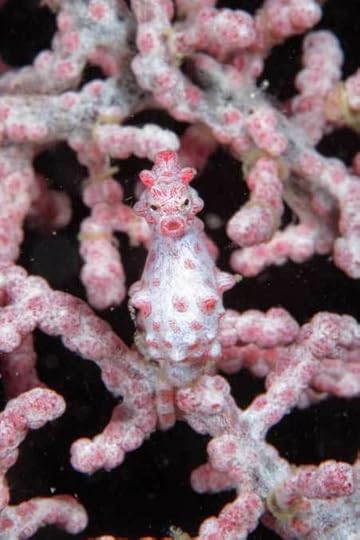
Okay, that one was easy. How about this one?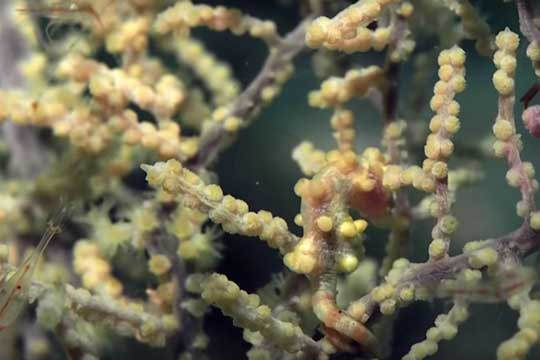
Check out this video of camouflaged seahorses.
What's up with that prehensile tail? Instead of caudal fins for swimming, seahorses have a tail that can wrap around coral, seagrass, or just about anything else. This holds them in place in rough waters or when there is a current.
And these tails serve another important purpose. Seahorses have elaborate mating rituals. In an attempt to impress a female, a male will lock its tail around the female and wrestle with her in an attempt to impress her. If the two pair up, then the real dance starts. And I really mean dance. The two seahorses begin an intricate series of movements that can last for hours. Sometimes with their tails wrapped together. That's almost romantic.
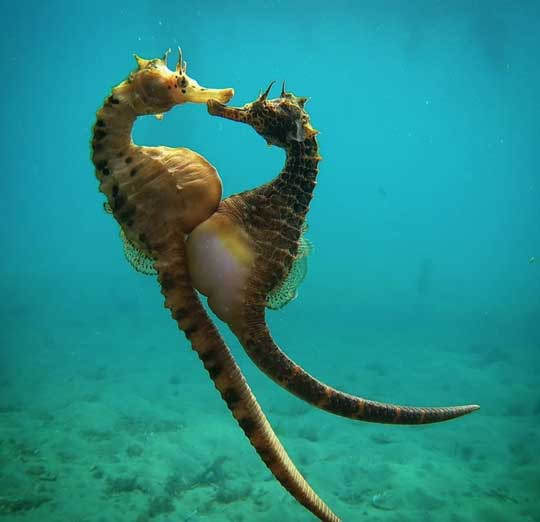
But there's something else amazing about seahorse reproduction. Are you ready for this? The males are the ones that get pregnant. How does that work, you ask? After their elaborate courtship dance, the female lays eggs into a special oviduct in the male's body, in the structure called the brood pouch. Then the male swims to a safe place and sits tight during gestation, which can last weeks. When the babies are ready to be born, the male starts having contractions that force the babies out. Depending on the seahorse species, there can be as few as five babies and as many as 2,500!
Unfortunately, baby seahorses have little chance of surviving. Studies show that as few as 0.5 percent (1 out of every 200) live to adulthood.

So, the Seahorse deserves a place in the D.A.H.O.F.
(Dandy Animal Hall of Fame).
FUN FACT: If the word dandy sounds old fashioned, that's because it is. The first recorded use of the word was between 1770 and 1780. Dandy has two meanings. The first is "a man who is excessively concerned about his clothes and appearance." That use of the word is rare these days. Today, the more common meaning is "something or someone of exceptional or first-rate quality." And there is something about a seahorse's appearance that makes me think the word dandy is perfect. So, dandy is another way to say awesome!
Photo Credits:
Seahorse 3 - Longsnouted Seahorse -Peter Ryngaert/ Guylian Seahorses of the World 2005 - via Smithsonian
Seahorse feeding - Fusedjaw.com
Seahorse Camo #1 - Klaus Stiefel on Flickr
Seahorse Camo #2 - Atsushi Sadaki/Caters News via Earthtouch News
Mating Seahorses - Jules Casey - Ocean Conservancy
Male Seahorse Giving Birth - YouTube
Anyway, while we were snorkeling, we found a seahorse. It was only about two inches long, but it was exciting because we had never seen one in the wild before. I can't find a photo of it because back then the only waterproof cameras we had were those plastic, disposable things that used film. Remember film?
So, what the heck is a seahorse?
Seahorses include about 40 species of fish in the genus Hippocampus. They live in shallow tropical and subtropical marine habitats, hiding in seagrasses, mangroves, coral reefs, and other sheltered areas. These fish are best known for their upright posture, prehensile tail, and the fact that their heads and necks vaguely resemble that of a horse. But few people have seen them in the wild because they don't move around much, and they blend in with their surroundings.

Amazing facts about seahorses
Seahorses are ridiculously bad swimmers. Top speed: 150 cm per hour. Their tail (called the caudal fin on other fish) are not for swimming, so they swim mostly using their small dorsal (back) fin. This fin flips back and forth furiously, but as Ze Frank says, “Imagine trying to propel yourself on a skateboard solely by waving a Denny’s menu back and forth really fast.”
(by the way, zefrank1 has a collection of funny nature videos on YouTube... but avoid them if you are offended by slightly-raunchy jokes)
In spite of their slow swimming speed, seahorses are predators, feeding on small crustaceans. Obviously, they don't chase down their food. Instead, they wait motionless until their prey swim by, then they suck in the prey through their tube-like mouths.

Seahorses don't have a stomach. Seriously. And no teeth. Their food passes through their digestive system so fast that they have to eat constantly. A young, growing seahorse will eat up to 3,000 brine shrimp every day! I like shrimp too, but sheesh!
A group of seahorses is called a herd. Well, duh.
Seahorses are amazing at hiding. This helps them avoid being eaten (remember, they can't swim worth a hoot), and it helps them catch their prey (they are ambush hunters). Can you spot the seahorse in this photo?

Okay, that one was easy. How about this one?

Check out this video of camouflaged seahorses.
What's up with that prehensile tail? Instead of caudal fins for swimming, seahorses have a tail that can wrap around coral, seagrass, or just about anything else. This holds them in place in rough waters or when there is a current.
And these tails serve another important purpose. Seahorses have elaborate mating rituals. In an attempt to impress a female, a male will lock its tail around the female and wrestle with her in an attempt to impress her. If the two pair up, then the real dance starts. And I really mean dance. The two seahorses begin an intricate series of movements that can last for hours. Sometimes with their tails wrapped together. That's almost romantic.

But there's something else amazing about seahorse reproduction. Are you ready for this? The males are the ones that get pregnant. How does that work, you ask? After their elaborate courtship dance, the female lays eggs into a special oviduct in the male's body, in the structure called the brood pouch. Then the male swims to a safe place and sits tight during gestation, which can last weeks. When the babies are ready to be born, the male starts having contractions that force the babies out. Depending on the seahorse species, there can be as few as five babies and as many as 2,500!
Unfortunately, baby seahorses have little chance of surviving. Studies show that as few as 0.5 percent (1 out of every 200) live to adulthood.

So, the Seahorse deserves a place in the D.A.H.O.F.
(Dandy Animal Hall of Fame).
FUN FACT: If the word dandy sounds old fashioned, that's because it is. The first recorded use of the word was between 1770 and 1780. Dandy has two meanings. The first is "a man who is excessively concerned about his clothes and appearance." That use of the word is rare these days. Today, the more common meaning is "something or someone of exceptional or first-rate quality." And there is something about a seahorse's appearance that makes me think the word dandy is perfect. So, dandy is another way to say awesome!
Photo Credits:
Seahorse 3 - Longsnouted Seahorse -Peter Ryngaert/ Guylian Seahorses of the World 2005 - via Smithsonian
Seahorse feeding - Fusedjaw.com
Seahorse Camo #1 - Klaus Stiefel on Flickr
Seahorse Camo #2 - Atsushi Sadaki/Caters News via Earthtouch News
Mating Seahorses - Jules Casey - Ocean Conservancy
Male Seahorse Giving Birth - YouTube
Published on January 23, 2019 06:17
January 7, 2019
Awesome Animal - Demon Duck of Doom
Yes! There really is a creature called the Demon Duck of Doom. Unfortunately (or fortunately, depending on your perspective), the creature is now extinct, And, as you've probably guessed, Demon Duck of Doom is not its official, scientific name. But the name is frequently used, even in books and museums, so by golly I'm going to call it the Demon Duck of Doom! Besides, this is the coolest, most awesomest animal name I've ever seen.
So, what the heck is a Demon Duck of Doom?
Well, first of all, it's a bird. A big bird. With a huge beak that was suited to tearing off chunks of flesh from creatures unfortunate enough to be its prey. It lived fifteen million years ago in what is now Australia, and its scientific name is Bullockornis planei.
On our trip to Australia last April and May, Trish and I were exploring the amazing Daintree Rainforest Discovery Centre, and we came upon this life-sized, robotic bird beside the trail (see photo below). I read the informational kiosk, saw the name Demon Duck of Doom, and knew I had to feature this bird as an awesome animal.
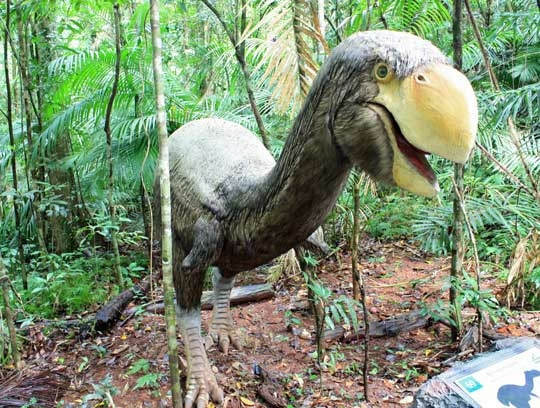
Amazing facts about the Demon Duck of Doom
Okay, first let's talk about the creature's name. The genus name, Bullockornis (which seems a little strange in and of itself), actually comes from Bullock Creek, the site in Australia's Northern Territory where the first fossils were found. The word bullock also means a bull or ox (usually one that has been castrated), and the -ornis part of the name means bird. So, many people mistakenly translate the name to ox-bird. But you now know this is incorrect. Feel free to use this knowledge to impress people at parties.
And then there's the creature's more colorful name, the Demon Duck of Doom. Some paleontologists (although not all) believe the Bullockornis is related to ducks and geese. This, combined with its size and its supposed predatory habits, led a PR-savvy writer to christen the creature Demon Duck of Doom in order to get more people interested. Sure, it's a silly name, but there's nothing wrong with trying to get more people interested in paleontology, right?
By the way, the Bullock Creek fossil site where this bird was found has also produced some other pretty impressive fossils, including marsupial "lions," giant horned tortoises, and giant wombats! If someone ever invents a time machine, and I get the opportunity to go back in time, Bullock Creek might be my location of choice. As long as I can take bite-proof body armor.

These creatures were big. Bullockornis stood a little over eight feet tall and weighed about 550 pounds (250 kg). This is heavier than a male lion (420 pounds) and almost as large as a male tiger (up to 670 pounds). And if you consider that the creature's head was the size of a horse's, sporting a massive beak with razor-sharp sawing edges, you can image that the creature had an imposing presence (that's a fancy way to say that coming face to face with one would be a pee-your-pants kind of experience).

But wait! Not all scientists believe Bullockornis was a fierce predator. Some scientists point out that the beak is not hooked (like we see in the beaks of most predatory birds like hawks and owls). They also argue that the bird may have had poor vision, whereas all modern predatory birds have excellent vision. They argue that the large, heavy beak may have evolved to help the bird slice through thick plant stalks or chomp into husky fruits.
Or perhaps the bird was what we call an opportunist, taking down weak or injured prey when it had the chance, but typically scavenging. I'm sure that, when it came across a dead animal, it could easily scare off other scavengers or predators, and then its beak could help it slice off tasty chunks of meat.
Look at the fossilized skull below. What is your opinion on this? Predator, herbivore, or scavenger?
If they ever definitely determine that these birds were herbivores, I think we'll have to get rid of the name, Demon Duck of Doom. The name would seem kind of ridiculous.
Based on the structure of the legs, it is thought that Bullockornis was a fast runner. This supports the idea that they were predators. Sure, many herbivores can run fast to escape predation, but the main predators of Bullockornis were crocodiles. Crocodiles can quickly burst from the water to grab prey, but they are not the kind of predators that would force an animal to run long distances across a large, open space. How do we know crocodiles ate these birds? Because the fossil bones have puncture marks that match the pattern of crocodile teeth.
Hmm... would it be worse to be attacked by a Demon Duck of Doom, or by a giant crocodile? That's a tough call. I choose neither.
Check out this video about the Demon Duck of Doom (and the Killer Kangaroo).
Believe it or not, the Demon Duck of Doom is NOT the largest prehistoric bird to have lived in Australia (although it does have the coolest name). Dromornis Stirtoni, sometimes called Stirtoni's Thunder Bird, weighed up to 650 kg. That's almost 1,500 pounds! Like the Demon Duck of Doom, the Stirtoni may have been a fierce predator, or it may have been an herbivore. We may never know.
I think the most intriguing thing about the Stirtoni is that it lived from 8 million years ago to less than 30,000 years ago. And the first humans to occupy Australia arrived there about 60,000 years ago. You know what that means, right? It means humans likely encountered this 1,500-pound bird. Perhaps those humans hunted it... or perhaps it hunted them!
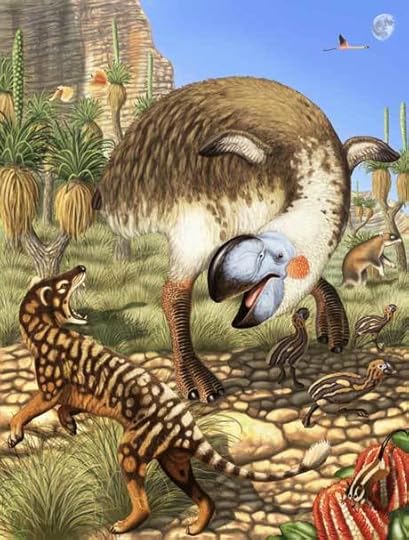
So, the Demon Duck of Doom deserves a place in the L.A.H.O.F. (Legendary Animal Hall of Fame).
FUN FACT: The word legendary comes from the Medieval Latin word legendārius and was first used in about 1505. Typically, it means celebrated or described in legend. But more recently it has been broadened to mean heroic, strange, or superhuman. And even more recently than that, it has been used to refer to anything that is widely (or not so widely) recognized as excellent. So, legendary is another way to say awesome!
Photo Credits:
Bullockornis mechanical model - Stan C. Smith
Drawing #1 - Nobu Tamura via Wikimedia Commons
Bullockornis Skull - Gord Webster via Wikimedia Commons
Size Comparison Chart - Prehistoric Wildlife
Dromornis sturtoni - Prehistoric Times Magazine
So, what the heck is a Demon Duck of Doom?
Well, first of all, it's a bird. A big bird. With a huge beak that was suited to tearing off chunks of flesh from creatures unfortunate enough to be its prey. It lived fifteen million years ago in what is now Australia, and its scientific name is Bullockornis planei.
On our trip to Australia last April and May, Trish and I were exploring the amazing Daintree Rainforest Discovery Centre, and we came upon this life-sized, robotic bird beside the trail (see photo below). I read the informational kiosk, saw the name Demon Duck of Doom, and knew I had to feature this bird as an awesome animal.

Amazing facts about the Demon Duck of Doom
Okay, first let's talk about the creature's name. The genus name, Bullockornis (which seems a little strange in and of itself), actually comes from Bullock Creek, the site in Australia's Northern Territory where the first fossils were found. The word bullock also means a bull or ox (usually one that has been castrated), and the -ornis part of the name means bird. So, many people mistakenly translate the name to ox-bird. But you now know this is incorrect. Feel free to use this knowledge to impress people at parties.
And then there's the creature's more colorful name, the Demon Duck of Doom. Some paleontologists (although not all) believe the Bullockornis is related to ducks and geese. This, combined with its size and its supposed predatory habits, led a PR-savvy writer to christen the creature Demon Duck of Doom in order to get more people interested. Sure, it's a silly name, but there's nothing wrong with trying to get more people interested in paleontology, right?
By the way, the Bullock Creek fossil site where this bird was found has also produced some other pretty impressive fossils, including marsupial "lions," giant horned tortoises, and giant wombats! If someone ever invents a time machine, and I get the opportunity to go back in time, Bullock Creek might be my location of choice. As long as I can take bite-proof body armor.

These creatures were big. Bullockornis stood a little over eight feet tall and weighed about 550 pounds (250 kg). This is heavier than a male lion (420 pounds) and almost as large as a male tiger (up to 670 pounds). And if you consider that the creature's head was the size of a horse's, sporting a massive beak with razor-sharp sawing edges, you can image that the creature had an imposing presence (that's a fancy way to say that coming face to face with one would be a pee-your-pants kind of experience).

But wait! Not all scientists believe Bullockornis was a fierce predator. Some scientists point out that the beak is not hooked (like we see in the beaks of most predatory birds like hawks and owls). They also argue that the bird may have had poor vision, whereas all modern predatory birds have excellent vision. They argue that the large, heavy beak may have evolved to help the bird slice through thick plant stalks or chomp into husky fruits.
Or perhaps the bird was what we call an opportunist, taking down weak or injured prey when it had the chance, but typically scavenging. I'm sure that, when it came across a dead animal, it could easily scare off other scavengers or predators, and then its beak could help it slice off tasty chunks of meat.
Look at the fossilized skull below. What is your opinion on this? Predator, herbivore, or scavenger?

If they ever definitely determine that these birds were herbivores, I think we'll have to get rid of the name, Demon Duck of Doom. The name would seem kind of ridiculous.
Based on the structure of the legs, it is thought that Bullockornis was a fast runner. This supports the idea that they were predators. Sure, many herbivores can run fast to escape predation, but the main predators of Bullockornis were crocodiles. Crocodiles can quickly burst from the water to grab prey, but they are not the kind of predators that would force an animal to run long distances across a large, open space. How do we know crocodiles ate these birds? Because the fossil bones have puncture marks that match the pattern of crocodile teeth.
Hmm... would it be worse to be attacked by a Demon Duck of Doom, or by a giant crocodile? That's a tough call. I choose neither.
Check out this video about the Demon Duck of Doom (and the Killer Kangaroo).
Believe it or not, the Demon Duck of Doom is NOT the largest prehistoric bird to have lived in Australia (although it does have the coolest name). Dromornis Stirtoni, sometimes called Stirtoni's Thunder Bird, weighed up to 650 kg. That's almost 1,500 pounds! Like the Demon Duck of Doom, the Stirtoni may have been a fierce predator, or it may have been an herbivore. We may never know.
I think the most intriguing thing about the Stirtoni is that it lived from 8 million years ago to less than 30,000 years ago. And the first humans to occupy Australia arrived there about 60,000 years ago. You know what that means, right? It means humans likely encountered this 1,500-pound bird. Perhaps those humans hunted it... or perhaps it hunted them!

So, the Demon Duck of Doom deserves a place in the L.A.H.O.F. (Legendary Animal Hall of Fame).
FUN FACT: The word legendary comes from the Medieval Latin word legendārius and was first used in about 1505. Typically, it means celebrated or described in legend. But more recently it has been broadened to mean heroic, strange, or superhuman. And even more recently than that, it has been used to refer to anything that is widely (or not so widely) recognized as excellent. So, legendary is another way to say awesome!
Photo Credits:
Bullockornis mechanical model - Stan C. Smith
Drawing #1 - Nobu Tamura via Wikimedia Commons
Bullockornis Skull - Gord Webster via Wikimedia Commons
Size Comparison Chart - Prehistoric Wildlife
Dromornis sturtoni - Prehistoric Times Magazine
Published on January 07, 2019 05:17
December 26, 2018
Awesome Animal - Pangolin
The pangolin is a strange mammal. Considering how bizarre it is, you'd think it would be more widely recognized. But I've discovered many people have never seen a picture of one, and even fewer would recognize the name Pangolin. I'm a sucker for the really weird creatures, so I'm excited to share this one with you.
So, what the heck is a Pangolin?
Pronounced pang-guh-lin. Pangolins are also called scaly anteaters. They are mammals in the family, Manidae. There are currently eight species, but we know of a number of extinct species. They are found in some areas of Asia and the southern half of Africa. Pangolins have the distinct honor of being the only mammals with large scales for protection.
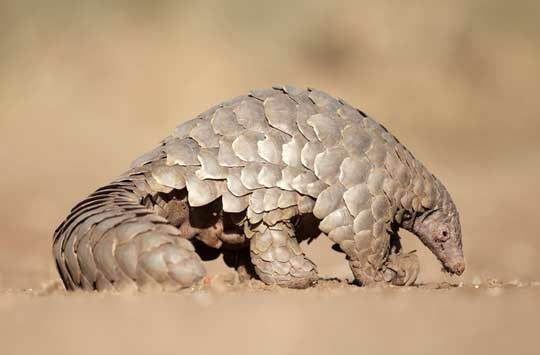
Amazing facts about the Pangolin
So what's up with those scales? A pangolin's scales are made of a protein called keratin, which is the same stuff that makes up human fingernails and hair. Keratin is also what makes up feathers, horns, hooves, and claws. So keratin is useful stuff! Pangolin scales are very different from the scales of reptiles, both in structure and composition.
The scales provide protection from predators. When attacked, a pangolin will roll into a ball and tuck its vulnerable head under its heavily-armored tail. In this position, they are nearly indestructible. Not even a lion can chew through the armor!

The scales make up about 20% of the animal's body weight. By the way, the underside of a pangolin is not covered in scales. Instead, it is supple skin with a few sparse hairs. So it's a good thing they can roll into a ball.
Pangolins have no teeth. Yep, that's right. In this respect, they are like anteaters and armadillos (although they are not closely related to either). Pangolins feed mostly on ants and termites. They have an extremely long, sticky tongue (sixteen inches long, which is sometimes longer than the pangolin's body... wow!), with which they slurp up insects at an amazing rate. They can eat 200 grams of bugs per night, which adds up to 70 million ants and termites per year! Obviously, they are important regulators of ant and termite populations in the areas where they live. Check out this pangolin's tongue:
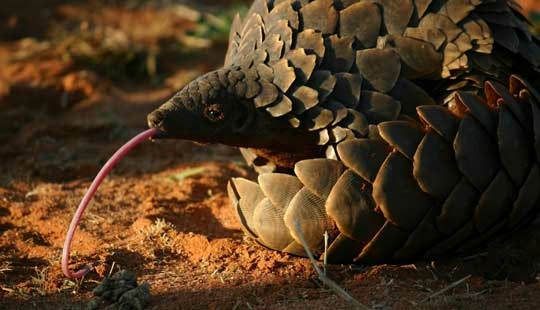
And take a look at this 11-second video of a pangolin sticking its tongue out! The tongue is coated with sticky saliva. A pangolin can shove its tongue deep into the tunnels of ant and termite nests, and when it pulls the tongue back out, it's covered with yummy, juicy bugs.
To help pangolins find all these ants and termites, they have long, sharp claws on their front feet for digging into the insects' mounds. They also use their claws to pull the bark from logs and trees to find ants and termites. In fact, they have prehensile tails, and they can hang upside down from a branch as they pull the bark from the tree's trunk.
Okay, if pangolins don't have teeth, how do they chew up all those ants and termites? While they are foraging, they swallow small pebbles. These pebbles go into a portion of their stomach called the gizzard. When the insect prey are swallowed and enter the muscular gizzard, the stones chew up the insects before the insects move on to the rest of the stomach. As you may know, birds also have gizzards since they don't have teeth.
Pangolins live most of their lives alone, getting together to mate only once per year. Most of the species give birth to only one baby. When the baby is born, its scales are soft (no doubt to make the birth easier on the mother!), but soon they harden and look like those of the adults. As the babies mature, they often ride around on the mother's back or on the top of her tail.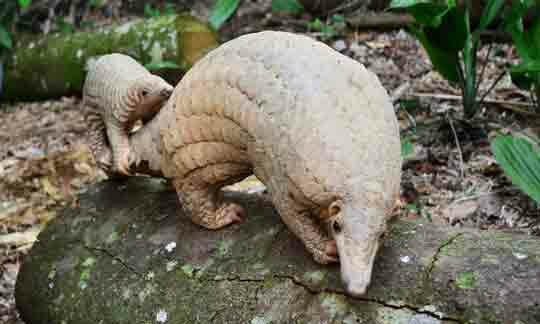
Unfortunately, the pangolin has the dubious distinction of being the Most Illegally Traded Mammal In The World. Since 2006, over a million pangolins have been taken from the wild to meet the demand for their scales and their meat (particularly in East Asia and parts of Africa). Their scales are considered essential for making some traditional medicines (but there is no evidence that any part of a pangolin has a beneficial effect on humans), and their meat is considered a delicacy.
But... things are looking better. In 2016, the Convention on International Trade in Endangered Species (CITES) passed a motion to move pangolins to Appendix I – offering all eight species of pangolin from both Asia and Africa the highest levels of protection, making trade in their parts completely illegal. This, and some aggressive public awareness campaigns should give these unique creature a better chance of surviving extinction.
You REALLY need to see this video! This is an ad from WildAid, to help make people aware of the plight of the pangolin and the new regulations banning the trade of pangolin products. It stars the awesome movie star, Jackie Chan.
One last tidbit. The third Saturday in February happens to be World Pangolin Day. That's February 16, 2019. This is to make more people aware of the pangolin's plight and the problems with buying pangolin products. There are many ways you can support World Pangolin Day (buy a t-shirt, post something on social media, and much more). One fun way to celebrate is to create a pangolin suit for your dog! You can get the instructions here, along with lots of other ideas and information.

So, the Pangolin deserves a place in the C.A.H.O.F.
(Crackerjack Animal Hall of Fame).
FUN FACT: The word crackerjack was first used in America in the 1890s. Prior to that was the form, crackajack, which was a whimsical word for an excellent fellow (crack = an adjective meaning first-rate or excellent, jack = a noun meaning a buddy or fellow). Today, crackerjack basically means "a person or thing that shows marked ability or excellence." So, crackerjack is another way to say awesome!
Photo Credits:
Pangolin #1 - Geographical
Pangolin with Lion - Daily Mail
Pangolin Tongue - National Geographic
Pangolin with Baby - Wildlife Reserves Singapore, via Zooborns
Pangolin Dog Suit - Sarah Pappin via Pangolins.org
So, what the heck is a Pangolin?
Pronounced pang-guh-lin. Pangolins are also called scaly anteaters. They are mammals in the family, Manidae. There are currently eight species, but we know of a number of extinct species. They are found in some areas of Asia and the southern half of Africa. Pangolins have the distinct honor of being the only mammals with large scales for protection.

Amazing facts about the Pangolin
So what's up with those scales? A pangolin's scales are made of a protein called keratin, which is the same stuff that makes up human fingernails and hair. Keratin is also what makes up feathers, horns, hooves, and claws. So keratin is useful stuff! Pangolin scales are very different from the scales of reptiles, both in structure and composition.
The scales provide protection from predators. When attacked, a pangolin will roll into a ball and tuck its vulnerable head under its heavily-armored tail. In this position, they are nearly indestructible. Not even a lion can chew through the armor!

The scales make up about 20% of the animal's body weight. By the way, the underside of a pangolin is not covered in scales. Instead, it is supple skin with a few sparse hairs. So it's a good thing they can roll into a ball.
Pangolins have no teeth. Yep, that's right. In this respect, they are like anteaters and armadillos (although they are not closely related to either). Pangolins feed mostly on ants and termites. They have an extremely long, sticky tongue (sixteen inches long, which is sometimes longer than the pangolin's body... wow!), with which they slurp up insects at an amazing rate. They can eat 200 grams of bugs per night, which adds up to 70 million ants and termites per year! Obviously, they are important regulators of ant and termite populations in the areas where they live. Check out this pangolin's tongue:

And take a look at this 11-second video of a pangolin sticking its tongue out! The tongue is coated with sticky saliva. A pangolin can shove its tongue deep into the tunnels of ant and termite nests, and when it pulls the tongue back out, it's covered with yummy, juicy bugs.
To help pangolins find all these ants and termites, they have long, sharp claws on their front feet for digging into the insects' mounds. They also use their claws to pull the bark from logs and trees to find ants and termites. In fact, they have prehensile tails, and they can hang upside down from a branch as they pull the bark from the tree's trunk.
Okay, if pangolins don't have teeth, how do they chew up all those ants and termites? While they are foraging, they swallow small pebbles. These pebbles go into a portion of their stomach called the gizzard. When the insect prey are swallowed and enter the muscular gizzard, the stones chew up the insects before the insects move on to the rest of the stomach. As you may know, birds also have gizzards since they don't have teeth.
Pangolins live most of their lives alone, getting together to mate only once per year. Most of the species give birth to only one baby. When the baby is born, its scales are soft (no doubt to make the birth easier on the mother!), but soon they harden and look like those of the adults. As the babies mature, they often ride around on the mother's back or on the top of her tail.

Unfortunately, the pangolin has the dubious distinction of being the Most Illegally Traded Mammal In The World. Since 2006, over a million pangolins have been taken from the wild to meet the demand for their scales and their meat (particularly in East Asia and parts of Africa). Their scales are considered essential for making some traditional medicines (but there is no evidence that any part of a pangolin has a beneficial effect on humans), and their meat is considered a delicacy.
But... things are looking better. In 2016, the Convention on International Trade in Endangered Species (CITES) passed a motion to move pangolins to Appendix I – offering all eight species of pangolin from both Asia and Africa the highest levels of protection, making trade in their parts completely illegal. This, and some aggressive public awareness campaigns should give these unique creature a better chance of surviving extinction.
You REALLY need to see this video! This is an ad from WildAid, to help make people aware of the plight of the pangolin and the new regulations banning the trade of pangolin products. It stars the awesome movie star, Jackie Chan.
One last tidbit. The third Saturday in February happens to be World Pangolin Day. That's February 16, 2019. This is to make more people aware of the pangolin's plight and the problems with buying pangolin products. There are many ways you can support World Pangolin Day (buy a t-shirt, post something on social media, and much more). One fun way to celebrate is to create a pangolin suit for your dog! You can get the instructions here, along with lots of other ideas and information.

So, the Pangolin deserves a place in the C.A.H.O.F.
(Crackerjack Animal Hall of Fame).
FUN FACT: The word crackerjack was first used in America in the 1890s. Prior to that was the form, crackajack, which was a whimsical word for an excellent fellow (crack = an adjective meaning first-rate or excellent, jack = a noun meaning a buddy or fellow). Today, crackerjack basically means "a person or thing that shows marked ability or excellence." So, crackerjack is another way to say awesome!
Photo Credits:
Pangolin #1 - Geographical
Pangolin with Lion - Daily Mail
Pangolin Tongue - National Geographic
Pangolin with Baby - Wildlife Reserves Singapore, via Zooborns
Pangolin Dog Suit - Sarah Pappin via Pangolins.org
Published on December 26, 2018 07:38
December 17, 2018
Awesome Animal - Olinguito (Kitty Bear)
My last two Awesome Animals were insects, and creepy ones at that. And so it's time to feature a cute and cuddly animal. Well, at least cute—wild animals are rarely cuddly. I wanted to choose an animal that many of you may not be familiar with. I was able to come up with one that had only recently been discovered, the Olinguito!
So, what the heck is an Olinguito?
Pronounced oh-lin-GHEE-toe. This creature is a mammal in the family Procyonidae (racoons, coatis, ringtails, kinkajous, and a few others). They live in the mountainous forests of western Colombia and Ecuador (South America). Astoundingly, the olinguito was identified only a few years ago, in 2013, making it the first carnivore mammal species identified in the Western Hemisphere in 35 years!
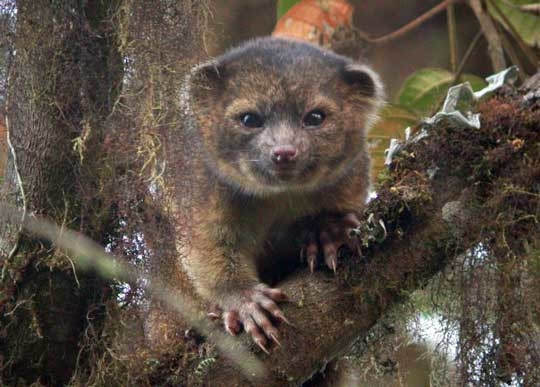
Amazing facts about the Olinguito
First, I should point out that this creature wasn't exactly discovered in 2013. It had already been observed in the wild for over 100 years. But it was properly identified in 2013. This was the result of a ten-year study of a group of mammals called olingos. A Smithsonian scientist, Kristofer Helgen, studied olingos in an attempt to understand how many different species existed. By looking at a number of types of evidence, including shape of the teeth and DNA analysis, he and his team figured out that the olinguito is not an olingo at all. Instead, it is an entirely different type of mammal, living much higher in the mountains than any of the olingos (olinguitos live from 5,000 to 9,000 feet above sea level).
The olinguito is known to the locals in Colombia and Ecuador as the "kitty bear." I'm guessing this is because these creatures look like a teddy bear but are the size of a kitten. If you need further proof that the olinguito is a cute critter, check out this immature:

Olinguitos are what we call omnivorous frugivores. That's just a fancy way to say they eat mainly fruit (frugivore), but they also eat a variety of other stuff (omnivorous) such as insects and nectar from flowers.
Olinguitos are the smallest members of the raccoon family, averaging only about two pounds (0.9 kg).
There's an interesting story behind the discovery that the olinguito is a unique species. In 1923, scientists embarked on a six-month expedition in Ecuador to collect specimens of all types of animals to better understand the wildlife there. During the trip, 1,500 mammal specimens were collected. One of them, Mammal #66573, was incorrectly labeled as a kinkajou. Below is the original expedition journal and the page detailing the collection of the first olinguito (described as a kinkajou).

This specimen sat in a drawer in the American Museum of Natural History for almost 90 years before being correctly identified.
In the 1970s, there was a female olinguito (named Ringerl) that spent her entire life displayed in zoos around the United States. The creature had been mislabeled as an olingo. Ringerl was frequently moved from one zoo to another because she refused to breed with the other olingos (well, duh!). Ringerl was the first and only live olinguito in captivity at that time.
In about 2003, a group of mammalogists led by Kristofer Helgen began a study of olingos by looking at museum specimens, and they came across the 1923 mislabeled specimen. By examining its skull, teeth, and fur, they decided it wasn't an olingo, it was a new species. So in 2006 they set out on an expedition to find out if this new species still existed in the wild. They found some of the animals and discovered they are nocturnal, they spend most of their time alone in the treetops, and they have only one baby at a time.
With the help of DNA analysis, by 2013 Helgen's team was ready to declare the olinguito a new species. It took ten years to accomplish this!
Check out this video of an olinguito
The photo below is of Ringerl, the first olinguito in captivity, moved from zoo to zoo in the 1970s.
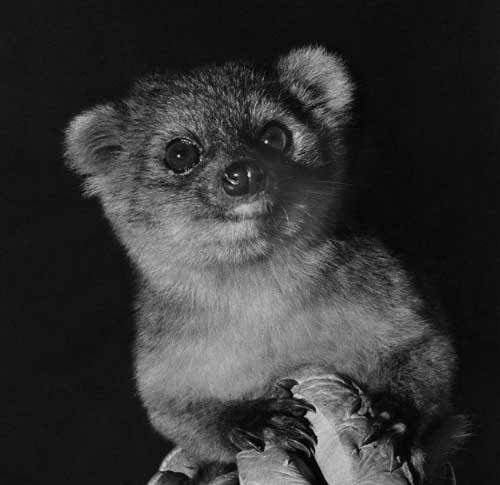
Interestingly, the announcement of this new species resulted in kind of a "crowdsourcing" flood of information that has helped scientists understand the creature. Soon after the announcement, Dr. Helgen received thousands of emails from naturalists, birdwatchers, and other people with sightings and observations. For example, people at the Bellavista Reserve in Ecuador emailed him that they had figured out a way to track individual olinguitos and monitor their feeding and mating habits. At a reserve in Colombia, people provided the documentation of a baby olinguito and new details about how the animals breed and nest. As a result, we now know much more about this amazing creature.
The olinguito story seems to appeal to everyone, including children. There have been several olinguito kids' books published in recent years.
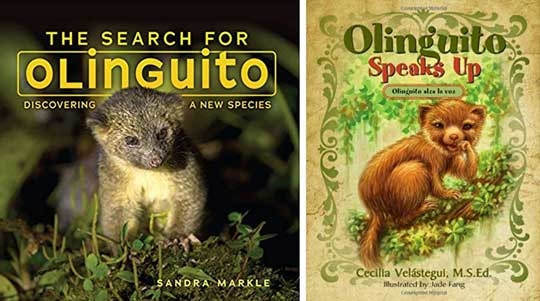
So, the Olinguito deserves a place in the B.A.H.O.F.
(Bully Animal Hall of Fame).
FUN FACT: The word bully was first used in the 1530s. It was from the Dutch word boele, which means lover. The word became a popular adjective after the US president Teddy Roosevelt used it frequently to describe something's awesomeness. He used the term "bully pulpit" to describe his powerful pulpit from which to speak to the country. So, bully is another way to say awesome!
Photo Credits:
Olinguito #1 - Mark Gurney, Smithsonian Insider
Baby Olinguito - Juan Rendon - Scientific American
Ecuador Expedition Journal - D.Finnin - American Museum of Natural History
Ringerl, the misidentified Olinguito - I. Popglayen-Neuwall - Smithsonian Institute
So, what the heck is an Olinguito?
Pronounced oh-lin-GHEE-toe. This creature is a mammal in the family Procyonidae (racoons, coatis, ringtails, kinkajous, and a few others). They live in the mountainous forests of western Colombia and Ecuador (South America). Astoundingly, the olinguito was identified only a few years ago, in 2013, making it the first carnivore mammal species identified in the Western Hemisphere in 35 years!

Amazing facts about the Olinguito
First, I should point out that this creature wasn't exactly discovered in 2013. It had already been observed in the wild for over 100 years. But it was properly identified in 2013. This was the result of a ten-year study of a group of mammals called olingos. A Smithsonian scientist, Kristofer Helgen, studied olingos in an attempt to understand how many different species existed. By looking at a number of types of evidence, including shape of the teeth and DNA analysis, he and his team figured out that the olinguito is not an olingo at all. Instead, it is an entirely different type of mammal, living much higher in the mountains than any of the olingos (olinguitos live from 5,000 to 9,000 feet above sea level).
The olinguito is known to the locals in Colombia and Ecuador as the "kitty bear." I'm guessing this is because these creatures look like a teddy bear but are the size of a kitten. If you need further proof that the olinguito is a cute critter, check out this immature:

Olinguitos are what we call omnivorous frugivores. That's just a fancy way to say they eat mainly fruit (frugivore), but they also eat a variety of other stuff (omnivorous) such as insects and nectar from flowers.
Olinguitos are the smallest members of the raccoon family, averaging only about two pounds (0.9 kg).
There's an interesting story behind the discovery that the olinguito is a unique species. In 1923, scientists embarked on a six-month expedition in Ecuador to collect specimens of all types of animals to better understand the wildlife there. During the trip, 1,500 mammal specimens were collected. One of them, Mammal #66573, was incorrectly labeled as a kinkajou. Below is the original expedition journal and the page detailing the collection of the first olinguito (described as a kinkajou).

This specimen sat in a drawer in the American Museum of Natural History for almost 90 years before being correctly identified.
In the 1970s, there was a female olinguito (named Ringerl) that spent her entire life displayed in zoos around the United States. The creature had been mislabeled as an olingo. Ringerl was frequently moved from one zoo to another because she refused to breed with the other olingos (well, duh!). Ringerl was the first and only live olinguito in captivity at that time.
In about 2003, a group of mammalogists led by Kristofer Helgen began a study of olingos by looking at museum specimens, and they came across the 1923 mislabeled specimen. By examining its skull, teeth, and fur, they decided it wasn't an olingo, it was a new species. So in 2006 they set out on an expedition to find out if this new species still existed in the wild. They found some of the animals and discovered they are nocturnal, they spend most of their time alone in the treetops, and they have only one baby at a time.
With the help of DNA analysis, by 2013 Helgen's team was ready to declare the olinguito a new species. It took ten years to accomplish this!
Check out this video of an olinguito
The photo below is of Ringerl, the first olinguito in captivity, moved from zoo to zoo in the 1970s.

Interestingly, the announcement of this new species resulted in kind of a "crowdsourcing" flood of information that has helped scientists understand the creature. Soon after the announcement, Dr. Helgen received thousands of emails from naturalists, birdwatchers, and other people with sightings and observations. For example, people at the Bellavista Reserve in Ecuador emailed him that they had figured out a way to track individual olinguitos and monitor their feeding and mating habits. At a reserve in Colombia, people provided the documentation of a baby olinguito and new details about how the animals breed and nest. As a result, we now know much more about this amazing creature.
The olinguito story seems to appeal to everyone, including children. There have been several olinguito kids' books published in recent years.

So, the Olinguito deserves a place in the B.A.H.O.F.
(Bully Animal Hall of Fame).
FUN FACT: The word bully was first used in the 1530s. It was from the Dutch word boele, which means lover. The word became a popular adjective after the US president Teddy Roosevelt used it frequently to describe something's awesomeness. He used the term "bully pulpit" to describe his powerful pulpit from which to speak to the country. So, bully is another way to say awesome!
Photo Credits:
Olinguito #1 - Mark Gurney, Smithsonian Insider
Baby Olinguito - Juan Rendon - Scientific American
Ecuador Expedition Journal - D.Finnin - American Museum of Natural History
Ringerl, the misidentified Olinguito - I. Popglayen-Neuwall - Smithsonian Institute
Published on December 17, 2018 06:18
December 1, 2018
Awesome Animal - Parasitic Wasp
One of the important themes in my newest novel
Bridgers 4
is the ability of certain creatures to control the minds and behaviors of other creatures. In
Bridgers 4
, certain creatures can control even humans (you must read the book to get the bizarre and frightening details). I've selected an Awesome Animal that is notorious for this ability—the parasitic wasp.
Actually, I should have featured these wasps closer to Halloween because they are kind of creepy. But, they're also absolutely fascinating.
So, what the heck is a Parasitic Wasp?
What I am referring to here is a family of wasps, called Ichneumonidae. Astoundingly, the ichneumonid (pronounced ick-noo-mon-id) wasps include over 60,000 species worldwide. Usually, when we think of wasps, we think of those nasty stingers. But the stingers of ichneumonid wasps have been modified to be ovipositors—a structure for laying eggs. And here is the fascinating (and creepy) part: they lay their eggs inside or on other creatures. Then their larvae, which are carnivorous, eat the host creature. And sometimes, the larvae actually control the behavior of the host, forcing it to do things that benefit the larvae.
Below is an ichneumonid wasp laying its eggs in cabbage-eating caterpillars.
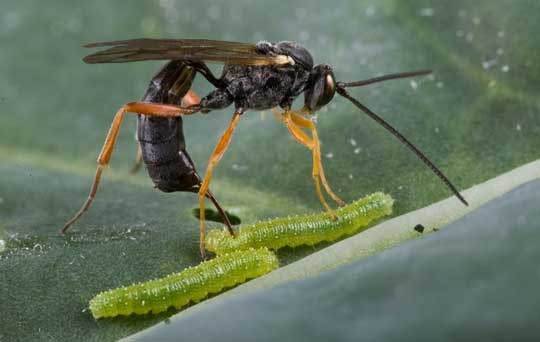
Amazing facts about Parasitic Wasps
First, I should point out that these wasps do not exactly fit the definition of parasite. Parasites (like ticks or tapeworms) rarely kill their hosts whereas these wasps almost always kill their hosts (the larvae consume the host creature). A more appropriate term is parasitoid. But I didn't want the title of this email to be too confusing, so I used the more familiar term. So, ichneumonid wasps are actually parasitoids.
In Bridgers 4 , Desmond, Lenny, and Xavier discuss an ichneumonid wasp that controls the behavior of orb-weaver spiders, so I'll begin with that amazing example. In the Central American tropics, there is a wasp that seeks out an orb-weaving spider, grabs the spider, and lays a single egg on the spider's abdomen. When the egg hatches, the worm-like larva attaches to the spider's abdomen and then starts sucking the spider's fluids out to say alive. See the larva attached to the orb-weaving spider below:
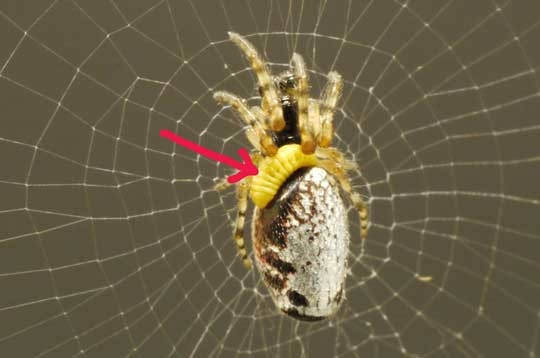
For a while, this doesn't seem to affect the spider. But when the wasp larva gets to a certain size, it injects a chemical that changes the spider's behavior. The spider stops making its normal, symmetrical web it uses for catching insects. Instead, it makes a very specific type of web, one that is much stronger and that is perfect for safely holding the wasp larva's cocoon. When the spider finishes the new web, the larva kills and eats the spider. The wasp larva then creates its cocoon on this nice, custom-designed web.
Check out this video about this wasp that forces spiders to weave a different web.
The photo below on the left is the spider's normal web, and on the right is the web the wasp forces the spider to weave:

The web on the right is stronger, requiring 2.7 to 40 times more force to snap the strands, compared to the normal web on the left. This makes the web more suitable for holding the wasp's cocoon. Also, the web on the right glows brightly when looked at under ultraviolet light, whereas the one on the left doesn't. This prevents insects and birds from accidentally flying into the web, again making it safer for the wasp's cocoon.
Researchers believe the wasp larvae inject their spider hosts with chemicals that mimic hormones the spiders produce naturally to trigger them to build resting webs. And then slight modifications to the chemicals could force the spiders to go over the same spots to reinforce the web and to add the extra UV visibility. What an amazing example of mind-control! It's like something from a science fiction story, right? Oh wait... I actually use this concept in Bridgers 4 .
But wait, there's more! There are many, many examples of wasps that can change the behavior of their hosts, essentially turning them into zombie slaves. Another example is the emerald wasp and its much-larger victim, the common household cockroach. The wasp stings the cockroach in a very precise spot of the roach's brain, injecting mind-controlling venom. The cockroach suddenly loses its ability to initiate its own movement. The wasp grabs the cockroach's antenna and leads it to a special chamber. The cockroach follows along, unable to resist, making it much easier for the wasp to take the larger victim to its doom. Once it leads the cockroach to the chamber, the wasp lays a single egg on the roach and then seals up the chamber with pebbles. The wasp larva hatches out, burrows into the cockroach, and then eats the cockroach from the inside. I know... gross and creepy. But so cool! Hmm... I wonder where Ridley Scott got the idea for the alien larvae for his 1979 film, Alien.
Below is the emerald wasp with its unfortunate victim:

Okay, can you handle one more example without having nightmares? There is a wasp called the Ladybird Parasite. The adult females of this wasp seek out adult female ladybird beetles. The wasp lays a single egg on the beetle's belly. After about a week, the wasp larva hatches. It already has wicked mandibles, and it proceeds to remove any beetle larvae or eggs, and then it enters the beetle's body and starts feeding on the beetle's insides. The beetle goes about its business for almost a month while the wasp larva feeds within it. When the wasp larva is ready to emerge, it paralyzes the beetle first. It then tunnels out and forms a cocoon attached to the beetle's belly.
The wasp in the cocoon develops beneath the ladybird beetle. Why? Well, ladybird beetles are brightly colored to scare away potential predators (the beetles secrete a nasty tasting chemical). And so the paralyzed beetle becomes the developing wasp's zombie bodyguard. The beetle even twitches its legs regularly, which helps to scare predators away. The photo below shows these zombie bodyguards with wasp cocoons beneath them.

I wish I could go on and on about animals that control the minds of other animals. There are even examples of parasitic fungi that do this! But, those will have to be topics for future Awesome Animal emails. Well... maybe in the next email I should feature an animal that is cute and cuddly?
So, the Parasitic Wasp deserves a place in the F.A.H.O.F.
(Formidable Animal Hall of Fame).
FUN FACT: The word formidable has been around since the early 1400s. It has several meanings, such as causing apprehension or dread, of awesome strength, and arousing feelings of awe because of grandeur or strength. Due to creepiness and horrifying habits of parasitic wasps, I thought this word was a good choice today. So, formidable is another way to say awesome! Photo Credits:
Wasp laying eggs in cabbage-eating caterpillar - Phys.org
Wasp larva on orb-weaving soider - NY Times
Orb-weaver web comparison - Smithsonian Insider
Emerald Wasp and cockroach - Deven Dadhawala on Flickr
Lady beetles carrying wasp cocoons - BBC
Actually, I should have featured these wasps closer to Halloween because they are kind of creepy. But, they're also absolutely fascinating.
So, what the heck is a Parasitic Wasp?
What I am referring to here is a family of wasps, called Ichneumonidae. Astoundingly, the ichneumonid (pronounced ick-noo-mon-id) wasps include over 60,000 species worldwide. Usually, when we think of wasps, we think of those nasty stingers. But the stingers of ichneumonid wasps have been modified to be ovipositors—a structure for laying eggs. And here is the fascinating (and creepy) part: they lay their eggs inside or on other creatures. Then their larvae, which are carnivorous, eat the host creature. And sometimes, the larvae actually control the behavior of the host, forcing it to do things that benefit the larvae.
Below is an ichneumonid wasp laying its eggs in cabbage-eating caterpillars.

Amazing facts about Parasitic Wasps
First, I should point out that these wasps do not exactly fit the definition of parasite. Parasites (like ticks or tapeworms) rarely kill their hosts whereas these wasps almost always kill their hosts (the larvae consume the host creature). A more appropriate term is parasitoid. But I didn't want the title of this email to be too confusing, so I used the more familiar term. So, ichneumonid wasps are actually parasitoids.
In Bridgers 4 , Desmond, Lenny, and Xavier discuss an ichneumonid wasp that controls the behavior of orb-weaver spiders, so I'll begin with that amazing example. In the Central American tropics, there is a wasp that seeks out an orb-weaving spider, grabs the spider, and lays a single egg on the spider's abdomen. When the egg hatches, the worm-like larva attaches to the spider's abdomen and then starts sucking the spider's fluids out to say alive. See the larva attached to the orb-weaving spider below:

For a while, this doesn't seem to affect the spider. But when the wasp larva gets to a certain size, it injects a chemical that changes the spider's behavior. The spider stops making its normal, symmetrical web it uses for catching insects. Instead, it makes a very specific type of web, one that is much stronger and that is perfect for safely holding the wasp larva's cocoon. When the spider finishes the new web, the larva kills and eats the spider. The wasp larva then creates its cocoon on this nice, custom-designed web.
Check out this video about this wasp that forces spiders to weave a different web.
The photo below on the left is the spider's normal web, and on the right is the web the wasp forces the spider to weave:

The web on the right is stronger, requiring 2.7 to 40 times more force to snap the strands, compared to the normal web on the left. This makes the web more suitable for holding the wasp's cocoon. Also, the web on the right glows brightly when looked at under ultraviolet light, whereas the one on the left doesn't. This prevents insects and birds from accidentally flying into the web, again making it safer for the wasp's cocoon.
Researchers believe the wasp larvae inject their spider hosts with chemicals that mimic hormones the spiders produce naturally to trigger them to build resting webs. And then slight modifications to the chemicals could force the spiders to go over the same spots to reinforce the web and to add the extra UV visibility. What an amazing example of mind-control! It's like something from a science fiction story, right? Oh wait... I actually use this concept in Bridgers 4 .
But wait, there's more! There are many, many examples of wasps that can change the behavior of their hosts, essentially turning them into zombie slaves. Another example is the emerald wasp and its much-larger victim, the common household cockroach. The wasp stings the cockroach in a very precise spot of the roach's brain, injecting mind-controlling venom. The cockroach suddenly loses its ability to initiate its own movement. The wasp grabs the cockroach's antenna and leads it to a special chamber. The cockroach follows along, unable to resist, making it much easier for the wasp to take the larger victim to its doom. Once it leads the cockroach to the chamber, the wasp lays a single egg on the roach and then seals up the chamber with pebbles. The wasp larva hatches out, burrows into the cockroach, and then eats the cockroach from the inside. I know... gross and creepy. But so cool! Hmm... I wonder where Ridley Scott got the idea for the alien larvae for his 1979 film, Alien.
Below is the emerald wasp with its unfortunate victim:

Okay, can you handle one more example without having nightmares? There is a wasp called the Ladybird Parasite. The adult females of this wasp seek out adult female ladybird beetles. The wasp lays a single egg on the beetle's belly. After about a week, the wasp larva hatches. It already has wicked mandibles, and it proceeds to remove any beetle larvae or eggs, and then it enters the beetle's body and starts feeding on the beetle's insides. The beetle goes about its business for almost a month while the wasp larva feeds within it. When the wasp larva is ready to emerge, it paralyzes the beetle first. It then tunnels out and forms a cocoon attached to the beetle's belly.
The wasp in the cocoon develops beneath the ladybird beetle. Why? Well, ladybird beetles are brightly colored to scare away potential predators (the beetles secrete a nasty tasting chemical). And so the paralyzed beetle becomes the developing wasp's zombie bodyguard. The beetle even twitches its legs regularly, which helps to scare predators away. The photo below shows these zombie bodyguards with wasp cocoons beneath them.

I wish I could go on and on about animals that control the minds of other animals. There are even examples of parasitic fungi that do this! But, those will have to be topics for future Awesome Animal emails. Well... maybe in the next email I should feature an animal that is cute and cuddly?
So, the Parasitic Wasp deserves a place in the F.A.H.O.F.
(Formidable Animal Hall of Fame).
FUN FACT: The word formidable has been around since the early 1400s. It has several meanings, such as causing apprehension or dread, of awesome strength, and arousing feelings of awe because of grandeur or strength. Due to creepiness and horrifying habits of parasitic wasps, I thought this word was a good choice today. So, formidable is another way to say awesome! Photo Credits:
Wasp laying eggs in cabbage-eating caterpillar - Phys.org
Wasp larva on orb-weaving soider - NY Times
Orb-weaver web comparison - Smithsonian Insider
Emerald Wasp and cockroach - Deven Dadhawala on Flickr
Lady beetles carrying wasp cocoons - BBC
Published on December 01, 2018 07:25
November 14, 2018
Awesome Animal - Tiger Beetle
Since
Bridgers 4
is coming soon, I've selected an Awesome Animal that makes an appearance in the book. Well, kind of... The creature in the story is given the name tiger beetle by one of the bridgers because it is fast and aggressive. But it is actually very different from the tiger beetles of our own world. You will have to read
Bridgers 4
to see how amazingly different the creature in the book really is.
So, what the heck is a Tiger Beetle?
Tiger beetles are a large group of beetles in the subfamily, Cicindelinae, with over 2,600 species and subspecies. What makes the tiger beetles so awesome? Well, they are strikingly colorful, they can run fast, and they are aggressive predators. Years ago, the first time I saw a tiger beetle, I didn't know what it was. I saw this green insect zipping back and forth on the ground, so fast that my eyes could hardly keep up with it. When it finally stopped, I got on my knees and observed a strikingly brilliant green beetle. It turned out to be the six-spotted tiger beetle:
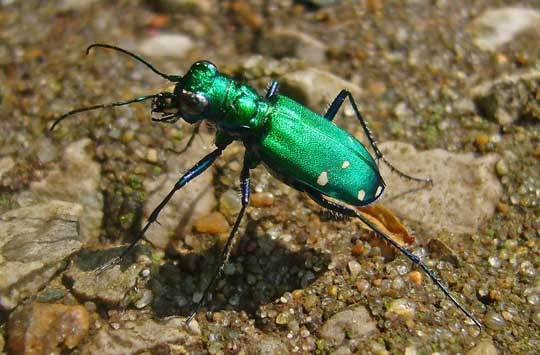
Amazing facts about Tiger Beetles
How fast are tiger beetles? They can run 5.6 miles per hour (9 km/hr). That may not sound fast, but if you consider the tiger beetle's size, this is about 125 body lengths per second! They are among the fastest runners of all insects.
They use this speed to catch their prey. But they do this in an unusual way. They sprint really fast for a short distance and then abruptly stop to visually reorient themselves. Then they take off running again. It is thought that they do this because their visual sensory system cannot keep up with their speed. They simply cannot process the visual images fast enough. So when you watch these insects run, you'll see them dart forward, stop, dart forward, stop, and so on.
Below is a festive tiger beetle from Nebraska (Central US).
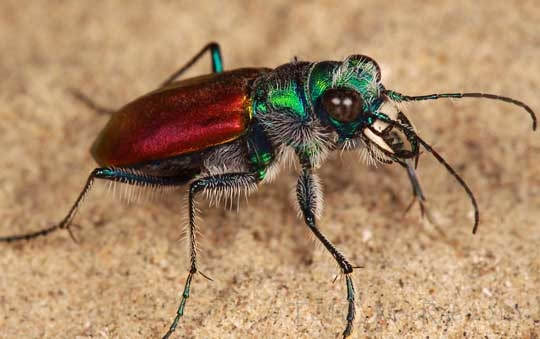
Tiger beetles have mandibles (jaws) that are adapted to their specific prey. Their large mandibles look kind of like serrated swords, and they are perfect for quickly grabbing and chewing up smaller insects. As the tiger beetle chews its prey, it sucks the yummy fluids out and then tosses aside the crunchy hard parts. Each species of tiger beetle has mandibles that are specific for the prey it eats. Those that have small mandibles eat only small insects, and those with large mandibles can feed on much larger prey. Because of this, it is possible for several types of tiger beetles to live in the same area because they don't compete for the same food.
Check out these chompers:
Tiger beetles can usually run fast enough to get away from predarors that might want to eat them. But sometimes they have to use their Plan B. If a very fast predator, like a lizard, chases them, they can quickly fly away. They don't usually fly far, perhaps twenty feet, but that's far enough to escape.
When it comes to escaping predators, tiger beetles have additional strategies. Some of them have patterns of spots and stripes on their backs that confuse predators, making it look like they aren't even an insect at all.
But perhaps the most impressive predator defense is the production of cyanide. You've probably noticed the bright colors of some of the beetles in these photos. The really bright ones are species that produce cyanide, which is extremely bitter and yucky. In fact, it can kill smaller predators that make the mistake of trying to eat a tiger beetle. These bright colors are a warning to predators to leave them alone. Check out this gold-spotted tiger beetle:
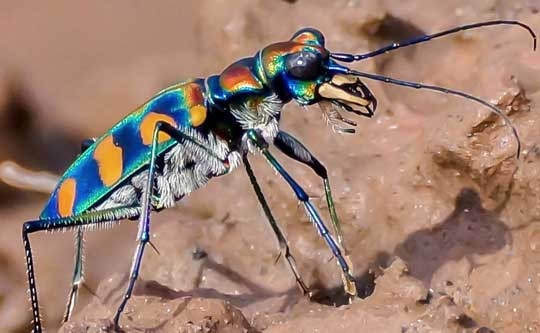
Tiger beetles often live in warm environments, and the ground can become very hot in the bright sun. Those tiger beetles that live in the hottest places often have exoskeletons that are light in color so that they don't absorb heat. They also have numerous hairs on their underside, which insulates them from the ground's heat. Not only that, but they have long legs that allow them to stand tall, putting distance between their bodies and the hot ground.
Well, I've explained that tiger beetles are vicious and effective predators. But their young, the larvae, are just as impressive. Tiger beetle larvae are like smaller versions of the creatures from the movie Tremors. The larvae have huge mandibles, and they use the mandibles to dig a tunnel in the soil. Then they back into the hole and sit there with only their head exposed, waiting for prey to come by. That's kind of creepy! And they have hooks at the back of the abdomen that grip the soil so that they can hold on to large prey they've grabbed.
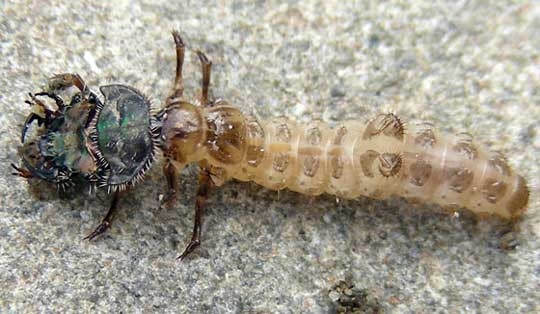
So, the Tiger Beetle deserves a place in the P.A.H.O.F.
(Prodigious Animal Hall of Fame).
FUN FACT: The word prodigious has been around a long time. It was first used in the 15th century. It means amazing, wonderful, or of a large quantity or size, and as far as I can tell, it has always had the same meaning. It is derived from the same Latin word that prodigy is derived from: prōdigiōsus.
So, prodigious is another way to say awesome!
Photo Credits:
Six-Spotted Tiger Beetle - Ted C. MacRae
Festive Tiger Beetle - Ted C. MacRae
Tiger Beetle Mandibles - Colin Hutton
Gold-spotted Tiger Beetle - Abhiroop Singh Gill
Tiger Beetle Larva - Stephen Hart
So, what the heck is a Tiger Beetle?
Tiger beetles are a large group of beetles in the subfamily, Cicindelinae, with over 2,600 species and subspecies. What makes the tiger beetles so awesome? Well, they are strikingly colorful, they can run fast, and they are aggressive predators. Years ago, the first time I saw a tiger beetle, I didn't know what it was. I saw this green insect zipping back and forth on the ground, so fast that my eyes could hardly keep up with it. When it finally stopped, I got on my knees and observed a strikingly brilliant green beetle. It turned out to be the six-spotted tiger beetle:

Amazing facts about Tiger Beetles
How fast are tiger beetles? They can run 5.6 miles per hour (9 km/hr). That may not sound fast, but if you consider the tiger beetle's size, this is about 125 body lengths per second! They are among the fastest runners of all insects.
They use this speed to catch their prey. But they do this in an unusual way. They sprint really fast for a short distance and then abruptly stop to visually reorient themselves. Then they take off running again. It is thought that they do this because their visual sensory system cannot keep up with their speed. They simply cannot process the visual images fast enough. So when you watch these insects run, you'll see them dart forward, stop, dart forward, stop, and so on.
Below is a festive tiger beetle from Nebraska (Central US).

Tiger beetles have mandibles (jaws) that are adapted to their specific prey. Their large mandibles look kind of like serrated swords, and they are perfect for quickly grabbing and chewing up smaller insects. As the tiger beetle chews its prey, it sucks the yummy fluids out and then tosses aside the crunchy hard parts. Each species of tiger beetle has mandibles that are specific for the prey it eats. Those that have small mandibles eat only small insects, and those with large mandibles can feed on much larger prey. Because of this, it is possible for several types of tiger beetles to live in the same area because they don't compete for the same food.
Check out these chompers:

Tiger beetles can usually run fast enough to get away from predarors that might want to eat them. But sometimes they have to use their Plan B. If a very fast predator, like a lizard, chases them, they can quickly fly away. They don't usually fly far, perhaps twenty feet, but that's far enough to escape.
When it comes to escaping predators, tiger beetles have additional strategies. Some of them have patterns of spots and stripes on their backs that confuse predators, making it look like they aren't even an insect at all.
But perhaps the most impressive predator defense is the production of cyanide. You've probably noticed the bright colors of some of the beetles in these photos. The really bright ones are species that produce cyanide, which is extremely bitter and yucky. In fact, it can kill smaller predators that make the mistake of trying to eat a tiger beetle. These bright colors are a warning to predators to leave them alone. Check out this gold-spotted tiger beetle:

Tiger beetles often live in warm environments, and the ground can become very hot in the bright sun. Those tiger beetles that live in the hottest places often have exoskeletons that are light in color so that they don't absorb heat. They also have numerous hairs on their underside, which insulates them from the ground's heat. Not only that, but they have long legs that allow them to stand tall, putting distance between their bodies and the hot ground.
Well, I've explained that tiger beetles are vicious and effective predators. But their young, the larvae, are just as impressive. Tiger beetle larvae are like smaller versions of the creatures from the movie Tremors. The larvae have huge mandibles, and they use the mandibles to dig a tunnel in the soil. Then they back into the hole and sit there with only their head exposed, waiting for prey to come by. That's kind of creepy! And they have hooks at the back of the abdomen that grip the soil so that they can hold on to large prey they've grabbed.

So, the Tiger Beetle deserves a place in the P.A.H.O.F.
(Prodigious Animal Hall of Fame).
FUN FACT: The word prodigious has been around a long time. It was first used in the 15th century. It means amazing, wonderful, or of a large quantity or size, and as far as I can tell, it has always had the same meaning. It is derived from the same Latin word that prodigy is derived from: prōdigiōsus.
So, prodigious is another way to say awesome!
Photo Credits:
Six-Spotted Tiger Beetle - Ted C. MacRae
Festive Tiger Beetle - Ted C. MacRae
Tiger Beetle Mandibles - Colin Hutton
Gold-spotted Tiger Beetle - Abhiroop Singh Gill
Tiger Beetle Larva - Stephen Hart
Published on November 14, 2018 07:44



